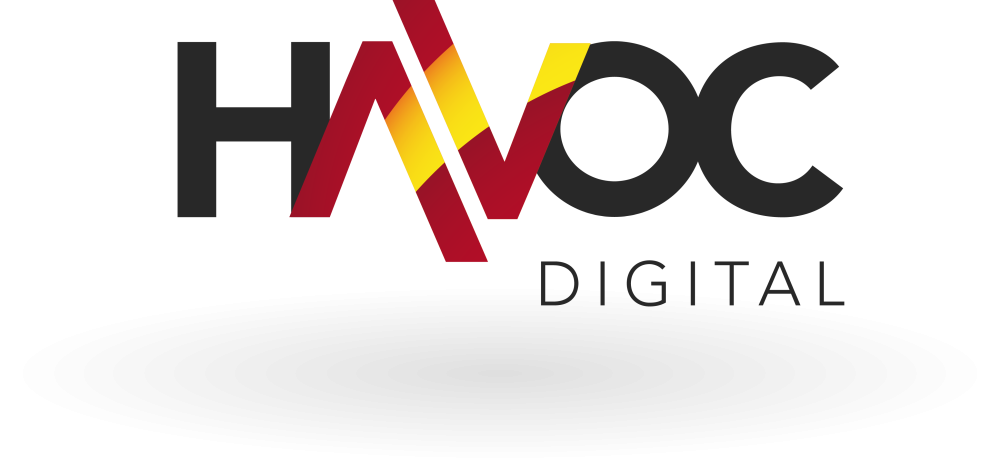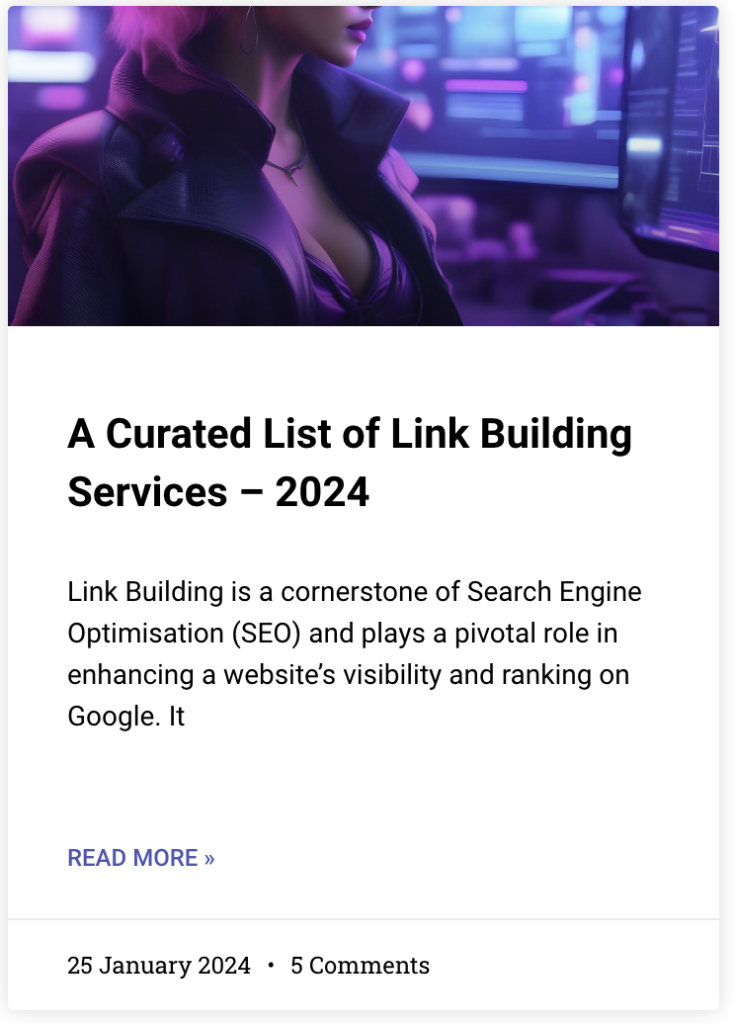Navigating Success: Innovative Marketing Strategies for Migration Agents to Amplify Client Engagement and Growth
I. Introduction

Overview of Migration Practice Marketing
Marketing a migration practice involves crafting and implementing strategies to attract and retain clients seeking immigration assistance.
It’s not just about promoting services; it’s about building trust, demonstrating expertise, and aligning with the specific needs and concerns of individuals and families navigating the complex landscape of migration laws and regulations.
In summary, we look at what encompasses effective marketing for migration practices:
1. Understanding the Unique Market Dynamics
Migration services cater to a diverse clientele, including skilled workers, international students, family reunification candidates, and refugees.
Each group has distinct needs and concerns, from navigating employment-based visa processes to understanding humanitarian and family-based migration pathways.
Effective marketing must address these varied needs with targeted messaging that resonates with each demographic.
2. Establishing Trust and Credibility
Trust is a cornerstone of any legal practice, especially in areas as sensitive and life-changing as immigration. Migration agents must establish a reputation for reliability, professionalism, and success. This is often achieved through:
Client Testimonials: Sharing success stories and positive outcomes to illustrate reliability.
Professional Credentials: Highlighting qualifications, certifications, and affiliations with respected industry bodies.
Informative Content: Offering valuable advice through blogs, newsletters, and social media to help potential clients understand their options and the migration process.
3. Digital Presence and Accessibility
A robust online presence is crucial. A user-friendly website that offers easy navigation, clear information on services, client testimonials, and a blog filled with helpful articles can significantly enhance a firm’s visibility and accessibility.
Additionally, search engine optimisation (SEO) strategies ensure that the practice appears prominently in search results related to migration services.
4. Engaging Through Social Media
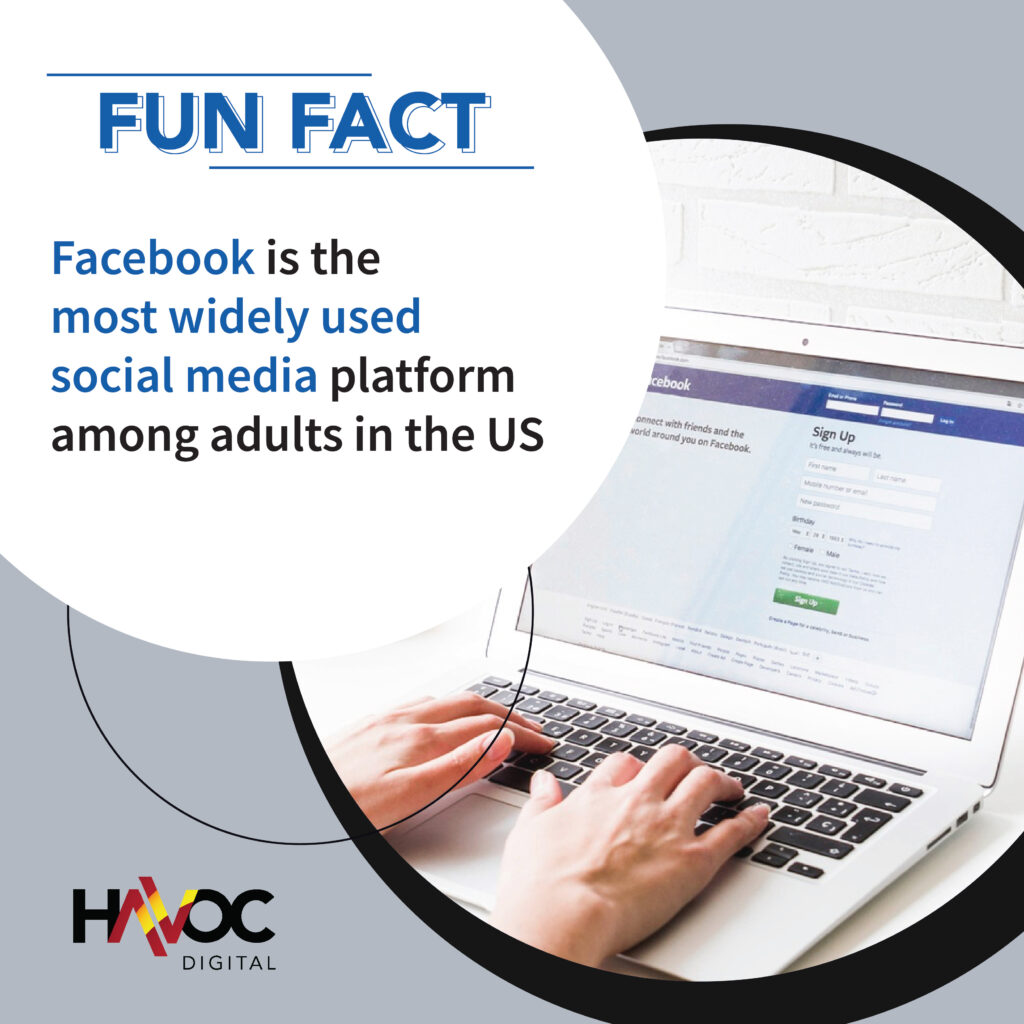
Social media platforms provide powerful tools for engagement and community building. Platforms like Facebook, LinkedIn, and Instagram allow migration agents to:
Share updates on immigration law and policy changes.
Post video content explaining complex legal processes in simpler terms.
Interact directly with followers through comments and direct messaging, fostering a personal connection.
5. Content Marketing
Developing and distributing valuable content is key to attracting and engaging potential clients. This can include:
Educational articles that address common questions or concerns.
When creating educational articles, especially those addressing migration or visa-related questions, it’s crucial to have a clear understanding of your target audience.
Readers are often looking for specific information that can guide personal decisions or resolve individual concerns. To effectively connect with and assist your audience, your content should be meticulously tailored.
This means not only addressing general queries but also diving into nuanced details that reflect common challenges faced by your readers. Incorporate real-world examples, actionable advice, and direct responses to typical questions to ensure your content is both relevant and valuable.
A Personal Favorite – Urine Tests for Student Visa’s:
Up until July 1, 2023, urine tests were mandatory for Australian student visa applicants as part of health examinations to screen for chronic kidney disease or diabetes. From that date, urine tests were replaced with blood tests. Applicants over 15 years old must undergo a blood test, while children between 5 and 14 are exempt unless clinically indicated. The type of health examinations required varies by the applicant’s country’s risk level and length of stay in Australia.
For more details, you can read the full article [here]
For migration agencies looking to keep subscribers informed about the latest immigration news and policy updates through newsletters, the Australian Immigration Bulletin (Members Only) offers a comprehensive resource.
It provides monthly updates on Australian immigration policies, strategies, and personal migration stories, making it a valuable tool for staying informed about changes and developments in the field. You can explore more and subscribe to their newsletter through [Immigrations Australia’s website].
Newsletters that keep subscribers informed about the latest immigration news and policy updates.
Here are two examples of newsletters that keep subscribers informed about the latest immigration news and policy updates, which can be valuable resources for migration agencies:
Roam Migration Law – Australian Immigration News & Insights: This newsletter offers updates and insights into Australian immigration laws and changes, providing valuable information for those interested in migration services.
The firm focuses on various visa categories and offers advice on navigating the complex immigration process. You can explore more about their offerings and subscribe to stay updated via their [website].
Eduaid – Australia, Canada & New Zealand Immigration Update: Eduaid provides a newsletter that covers significant updates and changes in immigration policies across Australia, Canada, and New Zealand.
This is especially useful for migration agencies looking to keep up with changes across different regions. Check out their latest updates and subscribe to their newsletter through their [website].
These newsletters are excellent tools for migration agencies to stay informed and provide up-to-date information to their clients.
They also help establish the agency’s credibility and expertise in the field by demonstrating an ongoing commitment to understanding and communicating the latest immigration news and policy updates.
Webinars and live Q&A sessions that provide direct advice and help establish the agent’s expertise in the field.
Webinars and live Q&A sessions focused on Australian migration that could be beneficial for migration agencies to utilise, be invited as a guest expert or draw inspiration from for marketing and establishing expertise:
DLegal Australian Migration Webinars: DLegal offers various webinars on Australian migration, covering topics like skilled migration, student visas to permanent residency pathways, and specific agreements like the Aged Care Industry Labour Agreement.
These sessions are interactive, allowing potential migrants to gain insights directly from experienced migration lawyers. More details on their upcoming webinars and registration can be found on [DLegal’s website].
Down Under Centre Events and Webinars: The Down Under Centre hosts free webinars providing information about migrating to Australia and New Zealand.
These webinars cover essential topics such as family migration, partner visas, and skilled visas, providing attendees with valuable information on visa opportunities and application strategies. You can explore more about their offerings and register for an event on [Down Under Centre’s page].
Migration Downunder Webinars: This organisation runs webinars that discuss various aspects of immigration and moving to Australia, including family migration and skilled visas.
These webinars are designed to help participants understand the complexities of the migration process and offer a platform for asking direct questions to migration experts. You can check their schedule and watch previous webinar recordings on [Migration Downunder’s webinar page].
These webinars and Q&A sessions provide a direct line of communication between migration experts and potential clients, making them an excellent tool for migration agencies to demonstrate their expertise and build trust with their target audience.

Creating your own Webinar and Q&A on LinkedIn
To successfully host a webinar and live Q&A session on LinkedIn to promote a migration agency practice, you’ll want to follow these steps:
1. Planning Your Own Webinar and Q&A Session
Define Your Goals
Objective Setting: Determine what you want to achieve with the webinar and Q&A session, such as increasing awareness, generating leads, or establishing thought leadership.
Choose a Relevant Topic
Topic Selection: Focus on topics pertinent to current issues in migration law, policy updates, or common challenges faced by your target audience.
Prepare Your Content
Content Development: Create a detailed presentation that includes key points, statistics, case studies, and actionable advice. Make sure the content is clear, informative, and directly addresses the needs of your audience.
Select the Right Tools
Technology Setup: Choose a reliable platform for hosting webinars that can integrate easily with LinkedIn, such as Zoom, WebEx, or Microsoft Teams.
2. Promoting Your Webinar on LinkedIn
Create an Event Page
Event Setup: Use LinkedIn’s Event feature to create an event page, providing all the necessary details like date, time, topic, and speaker information.
Leverage Your Network
Invitations: Send personalised invites to your LinkedIn contacts, and encourage them to share the event with relevant connections.
Engage Regularly
Content Sharing: Post regular updates about the webinar, including sneak peeks of the content, speaker introductions, or interesting facts to pique interest.
Use Sponsored Content
Paid Promotion: Consider using LinkedIn Ads to target specific demographics such as professionals interested in migration issues, ensuring wider visibility.
3. Hosting the Webinar
Technical Check
Setup: Ensure all technical equipment is tested and working properly before the event starts to avoid glitches.
Presentation Skills
Delivery: Deliver the webinar content confidently and engagingly, ensuring to speak clearly and pace your presentation well.
Interactive Elements
Engagement: Include polls, Q&A segments, and direct interactions with attendees to keep the session interactive and engaging.
4. Conducting the Live Q&A
Manage Time Effectively
Q&A Session: Dedicate a specific segment of the webinar to address questions from the audience. Use a moderator to help select and pose questions to ensure smooth flow.
Provide Thorough Answers
Responses: Offer detailed responses to questions, referring to specific laws, case studies, or hypothetical scenarios to provide value.
5. Post-Webinar Engagement
Follow-Up
Thank You Notes: Send a thank you message to all attendees with a link to the webinar recording and additional resources.
Share Highlights
Content Recycling: Post highlights or interesting Q&A exchanges on your LinkedIn profile to reach those who couldn’t attend.
Analyse Feedback
Feedback Collection: Use surveys or direct messages to gather feedback from participants to improve future webinars.
Nurture Leads
Lead Management: Engage with participants who showed interest in your services with tailored follow-up communications.
By following these steps, you can effectively use LinkedIn to host webinars and live Q&A sessions that promote your migration agency practice, build your professional brand, and engage directly with your target audience.
6. Community Involvement
Participating in community events, sponsoring local immigrant support groups, and forming partnerships with educational institutions are vital strategies for boosting visibility and establishing a strong community presence for your migration practice.
These activities also demonstrate a commitment to supporting migrants beyond just the business aspect, reflecting a deeper social responsibility.
Engage with Local Community Groups in Major Australian Cities
Local Partnerships: Actively seek partnerships with local community groups that cater specifically to immigrants.
In cities like Sydney and Melbourne, which boast large diverse populations, collaborating with cultural associations such as the Chinese Youth League or the Italian Social Club Altona can be particularly impactful.
Event Participation: Participate in or sponsor community events such as the Sydney Multicultural Community Services’ events or Melbourne’s Greek Festival. These engagements showcase your practice’s support for and commitment to diverse community segments.
Collaborate with Ethnic Social Clubs
Tailored Workshops: Collaborate with ethnic social clubs to offer workshops and seminars addressing specific migration issues relevant to their community members.
In Perth, engaging with the Perth Irish Club or the Indian Society of Western Australia can help address the unique challenges faced by these communities.
Visibility at Meetings: Regularly attend and participate in meetings held by these clubs.
In Brisbane, involvement with clubs like the Brisbane German Club or the Queensland African Communities Council can significantly increase your practice’s visibility and trust within these communities.
Support Local Sports Clubs
Sports Sponsorship: Sponsor local sports teams and clubs that are popular within immigrant communities. In cities like Adelaide, consider sponsoring teams like the Adelaide Croatian Raiders Soccer Club or the Polonia Adelaide Sports Club.
Event Hosting: Organise sports events or tournaments in collaboration with these sports clubs, which can serve as community-building activities and networking opportunities. Engaging with the Vietnamese Community in Australia – NSW Chapter for a football tournament can strengthen community ties.
Educational Collaborations
Scholarship Programs: Develop scholarship programs in collaboration with educational institutions that help immigrant students. This approach is particularly effective in cities with high immigrant populations such as Melbourne and Sydney.
Career Guidance: Offer career guidance sessions and legal advice on immigration-related issues at local schools and colleges, providing practical support to the youth in these communities, such as those in Canberra with a significant number of diplomatic and immigrant families.
Demonstrating Long-Term Commitment
Continuous Support: Ensure that the support provided goes beyond one-off events. Establish ongoing mentorship and support programs to assist immigrants with integration into the community, like partnering with the Hobart Bhutanese Community.
Feedback and Adaptation: Regularly collect feedback from community members and adapt your services to meet their evolving needs, ensuring that your commitment is responsive and enduring.
By enhancing your involvement in these community-focused activities and specifically engaging with ethnic community clubs in Australian capital cities, your migration practice not only becomes a recognised name at the grassroots level but also builds meaningful connections that can lead to a network of referrals and a loyal client base.
This strategic community engagement showcases a genuine commitment to enriching the lives of migrants, thereby elevating your practice’s reputation and impact.
7. Measuring Marketing Effectiveness
To continuously improve marketing strategies, it’s crucial to measure their effectiveness
Tools like Google Analytics for website traffic, social media analytics for engagement, and client feedback surveys can provide insights into what strategies are working and what areas need adjustment.
Marketing for migration practices is about more than just selling services; it’s about educating, supporting, and guiding individuals through one of the most important decisions of their lives.
By effectively using a mix of traditional and digital marketing strategies, migration agents can not only grow their practice but also make a significant positive impact on the lives of their clients.
Importance of Marketing in the Migration Industry
Marketing plays a crucial role in the migration industry, a field where trust, reliability, and expertise are paramount.
As migration agents and immigration lawyers navigate a complex and often sensitive landscape, effective marketing strategies can significantly impact their ability to attract and retain clients.
Here are the key reasons why marketing is so important in this sector:
1. Building Trust and Credibility
Establishing Expertise: Migration is a complex field that often requires navigating intricate legal systems and policies.
Effective marketing helps establish a firm or agent as an expert in the field, which is crucial for building client trust.
Demonstrating Success: Marketing provides a platform to showcase successful case studies and client testimonials, which are vital for proving competence and reliability in handling sensitive immigration matters.
2. Educating Potential Clients
Informing Decision-Making: Clients in the migration sector often face life-changing decisions.
Through educational content like blogs, videos, and seminars, marketers can help potential clients understand their options and the migration process, empowering them to make informed choices.
Demystifying the Process: The migration process can be daunting. Effective marketing strategies can demystify legal procedures and requirements, making the process seem less intimidating and more accessible.
3. Differentiating in a Competitive Market
Highlighting Unique Selling Points (USPs): In a competitive industry, distinguishing one’s services is crucial.
Marketing allows migration professionals to highlight their unique approaches, specialised services, or particular areas of expertise that set them apart from competitors.
Targeted Marketing Efforts: With a variety of visa types and client backgrounds, targeted marketing efforts can reach specific groups more effectively, whether they are students, skilled workers, families, or refugees.
4. Expanding Client Base
Reaching a Broader Audience: Digital marketing tools, including SEO and social media platforms, enable migration agents to reach a broader, even global audience.
This is especially important in the migration industry, where potential clients might be located in different parts of the world.
Leveraging Partnerships and Networks: Strategic marketing alliances with educational institutions, employment agencies, and community organisations can help increase referrals and expand client bases.
5. Maintaining Client Relationships
Engagement Strategies: Regular newsletters, updates on policy changes, and personalised follow-ups can help keep the firm top-of-mind for clients who might need additional services or can provide referrals.
Feedback and Improvement: Marketing channels also serve as platforms for client feedback, which is crucial for continuous improvement and client satisfaction.

6. Adapting to Market Changes
Responsive Strategies: The regulatory environment for migration is frequently subject to change.
Effective marketing allows migration firms to quickly communicate these changes to clients, helping them navigate new challenges and maintaining the firm’s role as a trusted advisor.
7. Enhancing Online Presence
Building an Online Community: By engaging potential clients through forums, social media, and interactive webinars, migration agents can build an online community that fosters trust and establishes a supportive network for migrants.
In the migration industry, where decisions are significant and impactful, the role of marketing cannot be overstated. It’s not only about promoting services but also about educating, empowering, and guiding clients through one of the most important journeys of their lives.
Effective marketing strategies ensure that migration agents can continue to serve their clients with integrity and excellence, making a real difference in their lives.
II. Understanding Your Market
Defining Your Target Audience
Effective marketing starts with a clear understanding of your target audience. For migration agencies, it’s essential to identify and understand the unique needs and aspirations of various client groups.
Here’s a deeper look into the primary categories:
Skilled Workers
Characteristics: Typically seek employment-based visas, are career-oriented, and look to migrate for job opportunities.
Needs: Information on job market trends, sponsorship opportunities, and professional networking in the target country.
Marketing Strategies: Highlight successful case studies, provide guides on navigating work visa applications, and showcase partnerships with multinational companies.
In the 2022-23 financial year, Australia saw a significant increase in migrant arrivals to 737,000, up 73% from 427,000 the previous year. This rise reflects a rebound from the travel restrictions imposed during the pandemic.
The majority of these arrivals were on temporary visas, totalling 554,000, indicating a robust recovery in sectors such as international education and temporary skilled employment.
【Ref: https://www.abs.gov.au/statistics/people/population/overseas-migration/latest-release】
The Skilled Independent visa (subclass 189), a key pathway for skilled workers, is part of Australia’s strategy to attract migrants who can fill critical skill shortages and contribute significantly to the economy.
The skilled migration stream is designed to address areas where local skills are unavailable and has been pivotal in supporting regional development and economic growth.
【Ref: https://immi.homeaffairs.gov.au/what-we-do/skilled-migration-program】
The 2023-24 Migration Program planning levels have allocated significant places for skilled migrants, reflecting the government’s focus on harnessing global talent to boost economic prosperity.
The skilled stream remains a major component of the migration intake, underscoring the importance of skilled migration in meeting labor market demands and driving economic activity.
【Ref: https://immi.homeaffairs.gov.au/what-we-do/migration-program-planning-levels】
For more detailed and recent statistics on Australia’s migration trends and skilled migration outcomes, you can refer to the [Australian Bureau of Statistics] and the [Department of Home Affairs] which provide comprehensive data and insights into migration patterns and policy impacts.
Families
Characteristics: Include couples, families with children, and extended families looking to reunite or relocate for a better quality of life.
Needs: Stability, social integration, educational opportunities for children, and long-term residency options.
Marketing Strategies: Emphasise family reunification success stories, explain family visa processes clearly, and create content around community integration and support services available in the destination country.

In the 2023-24 Australian Migration Program, the Family stream has been allocated 52,500 places, which represents about 28% of the total program. This allocation is slightly down from the previous year’s figures but remains a significant component of Australia’s migration intake.
The Family stream primarily supports the unification of family members with Australian citizens, permanent residents, and eligible New Zealand citizens, contributing to social cohesion and cultural diversity.
【Ref: https://www.fragomen.com/insights/australia-migration-program-planning-levels-for-2023-2024-announced.html】【Ref: https://immi.homeaffairs.gov.au/what-we-do/family-migration-program】.
This program covers various visa categories, including Partner, Parent, Child, and Other Family visas, each designed to meet different family reunification needs. For instance, Partner visas have moved to a demand-driven model, aiming to balance the program size with application demand to reduce processing times and backlogs.
【Ref: https://immi.homeaffairs.gov.au/check-twice-submit-once/applying-for-a-family-visa】.
Understanding these numbers and categories can help tailor marketing efforts for migration agencies focusing on family reunification services, emphasising the opportunities and support available for families looking to migrate to Australia.
For further details on the family stream of the Australian Migration Program and specific visa categories, you can visit the Department of Home Affairs’ [Family Migration Overview].
Students
Characteristics: Young individuals seeking international study experiences that could lead to career opportunities and permanent residency.
Needs: Information on study visas, part-time work opportunities while studying, post-graduation work rights, and pathways to permanent residency.
Marketing Strategies: Collaborate with educational institutions for seminars, provide checklists for successful student visa applications, and highlight alumni success stories.
As of December 2022, Australia hosted 619,371 international students, showing an 8% increase from the previous year. This upward trend indicates a recovery from the pandemic’s impact, with projections estimating the number could grow to 940,000 by 2025.
In terms of international student distribution by state, New South Wales and Victoria are the most popular destinations, hosting 182,093 and 140,403 students, respectively.
These figures highlight the significant role international students play in the Australian educational landscape, constituting 26% of all tertiary enrolments.
Interestingly, while they make up 15.5% of bachelor’s degree enrolments, their presence is much higher in master’s programs at 49.8%, and 33.4% in doctoral programs (Studying in Australia, 2023).
For more detailed statistics and trends, you can visit the pages on [Student Visa Statistics] and [International Students in Australia]for a comprehensive view.
Permanent Residency
Understanding the appeal and requirements of permanent residency in Australia is crucial for migration agents as it often represents the ultimate goal for many clients:
Characteristics: Applicants are often those who have already spent time in Australia on temporary visas such as students or skilled workers.
Needs: Detailed guidance through the application process, understanding of various pathways to residency, and management of expectations.
Marketing Strategies: Develop comprehensive guides on different permanent residency categories, explain the points-based system, and offer webinars or consultations on eligibility assessments.
In the 2023-24 Australian Migration Program, the government has allocated a total of 190,000 places for permanent migration. This allocation is split with a significant focus on skilled migrants, representing a commitment to addressing the nation’s workforce shortages and economic needs.
【REf: https://immi.homeaffairs.gov.au/what-we-do/migration-program-planning-levels】

The Family stream continues to be a vital part of the migration program, comprising 52,500 places, which allows for the reunification of families. This reflects the government’s emphasis on the social benefits of family reunification.
【Ref: https://www.fragomen.com/insights/australia-migration-program-planning-levels-for-2023-2024-announced.html】
In terms of permanent residency applications, a large proportion of applicants transition from temporary visas, including students and skilled workers, to permanent residency.
This shift often involves navigating complex pathways that require detailed guidance and understanding of various residency criteria and expectations.
【Ref: https://www.abs.gov.au/statistics/people/people-and-communities/migrant-settlement-outcomes/latest-release】
【Ref: https://www.abs.gov.au/statistics/people/people-and-communities/permanent-migrants-australia/latest-release】.
For more specific data and trends related to permanent migration to Australia, including detailed statistics and insights into economic contributions and outcomes for migrants, you might find it useful to refer to the Australian Bureau of Statistics and the Department of Home Affairs websites.
These sources provide comprehensive updates on migration trends and policy impacts.
– [Australian Bureau of Statistics – Migration](https://www.abs.gov.au)
– [Department of Home Affairs – Migration and Citizenship](https://www.homeaffairs.gov.au/what-we-do/migration-and-citizenship)
Visa Refusals & Cancellations
Handling visa refusals and cancellations represents a significant area of need where migration agents can provide indispensable service:
Characteristics: Clients who have faced setbacks in their immigration journey and seek professional help to address complex legal challenges.
Needs: Expert advice on appeal processes, representation in dealings with immigration authorities, and alternative visa options.
Marketing Strategies: Share case studies of successfully overturned decisions, offer free initial consultations for affected individuals, and create detailed FAQs on how to deal with visa refusals or cancellations.
In the 2022-23 financial year, Australia’s visa refusal and cancellation rates have been notably significant, particularly under the character provisions of section 501 of the Migration Act.
This section often leads to consequential cancellations or refusals of other pending applications when a primary decision is made. The exact numbers and trends in visa refusals and cancellations are detailed annually, highlighting the rigorous enforcement of character requirements.
The Australian Department of Home Affairs actively documents and updates these statistics, reflecting their ongoing commitment to maintaining the integrity of the immigration system.
Specific data on visa cancellations and refusals for this period underscore the challenges faced by applicants, which can arise from various compliance or character-related issues.
However, the exact figures detailing the number of these cancellations and refusals aren’t provided in the accessible content from the Department’s official sources.
For precise data, including numbers and possibly reasons for these visa decisions, you should consult the latest reports or contact the Department of Home Affairs directly via their official website: Department of Home Affairs.
For more detailed statistics and procedural information, you can visit the Department of Home Affairs’ visa statistics section and the Administrative Appeals Tribunal’s official site:
– [Department of Home Affairs Visa Statistics](https://www.homeaffairs.gov.au/research-and-statistics/statistics/visa-statistics)
– [Administrative Appeals Tribunal (AAT)](http://www.aat.gov.au/apply-online)
By deeply understanding the market and defining the target audience, migration agencies can tailor their marketing efforts to address the specific needs, fears, and aspirations of each client segment.
This targeted approach not only enhances the effectiveness of the marketing efforts but also builds trust and credibility among potential clients, paving the way for successful client relationships and a reputable migration practice.
Market Research Techniques
Market research has evolved with digital tools that enhance the depth and reach of data collection and analysis. Here’s a look at some modern techniques:
Surveys and Questionnaires: Still essential for gathering quantitative data, now often deployed through online platforms for broader reach and efficiency.
Interviews and Focus Groups: Conducted virtually to access a global participant pool, providing qualitative insights into consumer attitudes.

Observational Research: Enhanced by data analytics tools that track user interactions online and through mobile apps in real time.
Market Segmentation and Competitive Analysis: Leveraging big data to perform more detailed segmentation and real-time competitive analysis.
SWOT Analysis: Now integrates data from diverse digital sources for a comprehensive view.
Google Analytics: Used to analyse website traffic and user behavior, helping businesses understand how consumers interact with their online platforms.
Online Research Platforms: Platforms like Statista, SEMRush, and AHREFs provide access to a wide range of market data, trends, and forecasts.
These modern techniques provide a richer, more comprehensive view of the market, allowing businesses to tailor their strategies more effectively and respond quickly to changing consumer needs.
Competitive Analysis
Competitive analysis is a crucial component of strategic planning in business, providing insights into the market landscape, competitor strategies, strengths, and weaknesses.
Here’s a detailed look at how to conduct and utilise competitive analysis effectively:
1. Identify Competitors
Start by identifying your direct and indirect competitors. This includes not only the obvious rivals but also those in adjacent markets that could move into your space.
Use tools like industry reports, search engines, and trade associations to create a comprehensive list.
2. Gather Information
Collect as much data as you can about your competitors. This involves:
Product Offerings: What products or services do they provide? How do these compare to yours in terms of features, quality, and pricing?
Market Position: What is their market share, and what positions do they occupy in the industry?
Sales Tactics and Results: How do they promote their products, and what has been their success rate?
Customer Base: Who are their customers? How loyal are these customers?
Operational Techniques: How efficient are their operations? What are their costs?
Strengths and Weaknesses: What are they good at, and where do they falter?
3. Analyse Their Strategy
Understand the business strategies of your competitors.
This includes their growth strategies, advertising approaches, pricing tactics, and customer service philosophies.
This understanding can help you anticipate their future moves and prepare counter-strategies.
4. Examine Their Online Presence
In today’s digital age, analysing a competitor’s online presence is crucial. This includes:
Website and SEO Strategy: How well is their site optimised for search engines?
Social Media Usage: How active are they on social media, and what kind of engagement do they achieve?
Content Marketing: What type of content do they produce, and how effective is it at attracting and retaining customers?
5. Utilise SWOT Analysis
Conduct a SWOT (Strengths, Weaknesses, Opportunities, Threats) analysis to compare your business with the competition.
This will help you identify your competitive advantage and areas where you need improvement.
Example SWOT Analysis for a Migration Agency
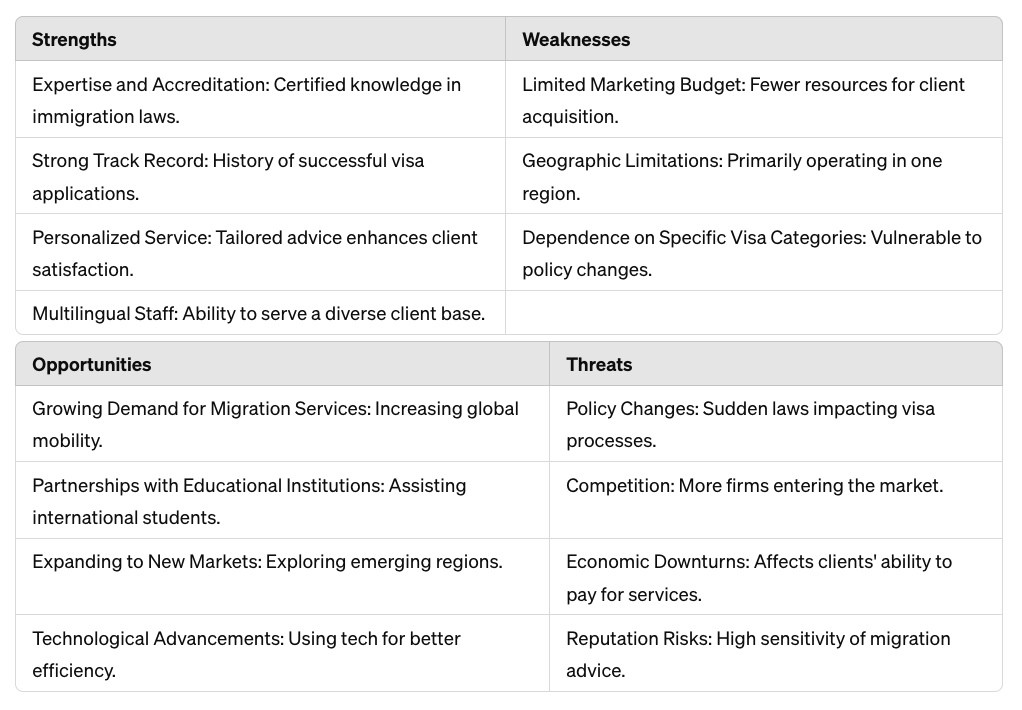
This SWOT analysis provides a structured insight into how the migration agency can leverage its strengths, address weaknesses, seize opportunities, and mitigate threats to maintain a competitive edge in the market.
6. Monitor Changes and Trends
Keep an ongoing tab on your competitors. Markets evolve, and new competitors can emerge quickly.
Use tools like Google Alerts, SEMrush, and AHREFs to monitor industry keywords and competitor names.
7. Act on the Information
Finally, use the insights gained from the competitive analysis to refine your business strategies. This could involve:
Adjusting Pricing: If you find competitors offer better value, consider revising your pricing strategy.
Improving Product Features: Enhance your offerings to ensure they meet or exceed industry standards.
Targeting New Markets: If competitors are overlooking certain customer segments, consider targeting these groups.
Strengthening Customer Relationships: Increase customer loyalty programs or improve service to retain your customer base.
Competitive analysis is not a one-time task but an ongoing process that should inform your strategic decisions continuously.
By understanding your competitors, you can better position your business to compete effectively, respond dynamically to market changes, and capitalise on opportunities before others do.
III. Branding Your Practice
Creating a Brand Identity
Creating a strong brand identity is essential for any business, including a migration practice. It helps distinguish your services from competitors, builds client trust, and enhances your market presence.
Here’s how to develop a compelling brand identity:
1. Define Your Brand Core
Mission Statement: Articulate what your practice aims to achieve beyond profit. This could be facilitating seamless migration processes or reuniting families across borders.
Vision Statement: This looks forward to the future impact of your practice. What long-term change do you aim to bring about in your industry or in your clients’ lives?
Core Values: Determine what principles guide your business practices. These could include integrity, dedication to client success, transparency, or innovation.
2. Identify Your Unique Selling Proposition (USP)
Pinpoint what makes your practice unique. Is it your unparalleled success rates, your specialised knowledge in a particular visa category, or perhaps your personalised client service?
This USP should be a focal point in your marketing materials and brand messaging, distinguishing you in a crowded marketplace.

3. Develop a Visual Identity
Logo: Design a logo that reflects your practice’s values and appeal. It should be distinctive yet simple enough for easy recognition.
Colour Scheme: Choose colors that evoke the emotions you want associated with your brand. For instance, blue can convey trust and security, while green might represent growth and success.
Typography: Select fonts that are readable and reflect your brand’s personality. Consistency in typography helps reinforce brand recognition.
4. Craft Your Brand Voice
This is the consistent way your brand communicates with the audience. Whether professional, friendly, informative, or empathetic, the voice should reflect your brand’s personality and appeal to your target demographic.
Your brand voice should be consistent across all content, including website copy, social media posts, brochures, and all client communications.
5. Integrate the Brand Across All Touch Points
Digital Presence: Ensure your website and social media profiles reflect your visual and verbal brand identity. They should be professional, user-friendly, and informative.
Client Interactions: From the greeting in your emails to the decor in your office, every point of interaction should reinforce your brand identity.
Advertising and Marketing Materials: Whether digital ads, print brochures, or billboards, maintain a consistent brand look and message.
6. Monitor and Evolve Your Brand
Regularly assess how your brand is perceived through client feedback and market analysis. Is your brand identity achieving the desired market position and client loyalty?
Stay adaptable. As market dynamics and client needs evolve, so too should your brand, always aiming to stay relevant and resonant with your target audience.
Creating a brand identity for your migration practice involves a deep understanding of your mission, unique strengths, and client needs.
By clearly defining and consistently presenting your brand across all platforms and interactions, you not only enhance your visibility in the market but also build a trusted reputation that can lead to increased client engagement and loyalty.
This foundation supports all other marketing and operational strategies, driving your practice towards long-term success.
Brand Positioning in the Migration Sector
Brand positioning in the migration sector involves defining how your migration practice stands out in a competitive landscape.
It’s about carving a distinct image in the minds of your potential clients that reflects what you stand for, the uniqueness of your services, and why clients should choose you over others.
Here’s how to strategically position your brand within the migration industry:
1. Understand Your Market
Market Analysis: Conduct thorough research to understand the broader migration sector, including trends, client demographics, and regulatory changes.
This will help you identify niches or under-served areas where your practice can specialise.
Competitor Analysis: Analyse your competitors’ strengths and weaknesses. Understanding what others are offering can help you identify gaps in services or areas where you can offer something better or different.
2. Define Your Target Audience
Identify specific groups within the broader market that your services are best suited for, such as students, families, skilled professionals, or refugees.
Understanding the specific needs, preferences, and challenges of these groups will allow you to tailor your messaging and services effectively.
3. Craft Your Value Proposition
Develop a clear and compelling value proposition that speaks directly to how your services solve the specific problems of your target audience.
This could involve unique service offerings like faster processing, lower fees, higher approval rates, or specialised expertise in complex cases.
4. Differentiate Your Practice
Service Differentiation: Highlight aspects of your service that are unique, such as personalized client care, a multilingual team, or expertise in a particular country’s immigration law.
Experience and Credibility: Leverage your track record of success and any professional certifications to build credibility.
Testimonials and case studies can be powerful tools to showcase your expertise and reliability.
5. Communicate Your Brand
Messaging Strategy: Develop key messages that consistently communicate your value proposition across all marketing channels. Whether through your website, social media, advertising, or public relations, ensure that your core messages are clear and persuasive.
Visual Identity: Use a consistent visual style that reflects your professional identity and resonates with your target audience. This includes everything from your logo and color scheme to the design of your marketing materials.

6. Engage with Cultural Sensitivity
Since migration often involves cross-cultural interactions, it’s crucial that your brand communicates cultural sensitivity and understanding.
This can involve highlighting your staff’s cultural competencies or your understanding of various immigration challenges faced by different communities.
7. Leverage Digital Marketing
Utilise SEO, content marketing, social media, and online advertising to reach a broader audience. Tailor your online content to address common questions and concerns of potential clients, positioning your brand as a helpful and authoritative resource in the migration space.
8. Monitor and Adapt
Continuously monitor how your brand is perceived through client feedback and market performance. Be prepared to make adjustments to your brand positioning based on changes in the market or in your business strategy.
Effective brand positioning in the migration sector requires a clear understanding of your market, meticulous crafting of your messaging, and consistent communication across all channels.
By positioning your brand as the go-to expert in specific areas of migration, you can build a strong, trusted brand that attracts and retains clients.
This strategic positioning not only differentiates your practice from competitors but also enhances your visibility and influence in the industry.
Developing a Unique Value Proposition (UVP)
A unique value proposition (UVP) is a clear statement that describes the benefit of your offer, how you solve your customer’s needs, and what distinguishes you from the competition.
In the context of a migration agency, developing a UVP is crucial for attracting clients by clearly stating why they should choose your services over others.
Here’s how you can develop a compelling UVP for your migration practice:
1. Identify Client Needs
Start by understanding the specific needs and challenges faced by your target audience. This could include issues like navigating complex visa applications, seeking family reunification, or moving for employment.
Conduct surveys, interviews, or focus groups with current and potential clients to gather insights about their expectations and pain points.
2. Analyse Your Services
List the services you offer, focusing on those aspects that directly address the needs you’ve identified. Highlight any specialised services that are not commonly offered by competitors.
Assess the aspects of your service delivery that clients value most, whether it’s speed, success rate, personalised attention, or cost-efficiency.
3. Evaluate Competitor Offerings
Review what your competitors claim as their strengths. This will help you identify areas where you can differentiate yourself.
Look for gaps in competitors’ offerings where your agency could potentially excel and meet unaddressed client needs.
4. Articulate Your Unique Advantages
Determine what makes your agency unique. It could be your depth of expertise, the ease of your process, your track record, or the comprehensive nature of your service.
Use this information to craft a statement that succinctly describes what you offer, how it benefits your clients, and why it’s different from what others provide.
5. Refine Your Message
Keep your UVP concise and jargon-free. It should be easily understandable to anyone, especially potential clients who might not be familiar with migration terminology.
Ensure that your UVP focuses on the benefits to the client, not just the features of your service. Explain how your services translate into real-world advantages for them.
6. Test and Refine
Share your UVP with a small segment of your target audience and gather feedback. Use this feedback to refine your message.
Consider A/B testing different versions of your UVP in your marketing materials to see which one resonates more with your audience.
7. Integrate Across Channels
Once finalised, consistently use your UVP across all marketing channels — your website, social media, brochures, and advertising. Consistency helps reinforce your message and brand identity.
Train your team to understand and communicate the UVP effectively in all client interactions.
Your unique value proposition is a cornerstone of your marketing and client interaction strategies. It not only helps potential clients understand why they should choose you but also aligns your internal team to what makes your agency special.
A well-crafted UVP acts as a beacon that attracts clients to your practice, guiding them in their decision-making process and setting the tone for all subsequent interactions.
IV. Traditional Marketing Strategies
Print Media Advertising
Print media advertising remains a valuable tool in the marketing mix, especially in sectors like migration services where trust and credibility are paramount.
Here’s how to effectively utilise print media advertising for a migration agency:
1. Understanding the Audience
Demographic Targeting: Identify which segments of your audience consume print media. This could include older demographics who prefer traditional over digital media or specific ethnic communities through community-based publications.
Geographic Focus: Use local newspapers and magazines to target potential clients in specific areas, especially if your agency focuses on helping migrants in particular cities or regions.
2. Choosing the Right Platforms
Newspapers: Daily or weekly newspapers can be a good choice for reaching a broad audience. Consider both major city newspapers and smaller, local papers which may offer more targeted advertising opportunities.
Magazines: Specialised magazines related to travel, culture, or specific industries relevant to your clients (like tech or healthcare) can be effective.
Trade Journals: If your agency specialises in business or investor visas, advertising in trade journals read by business professionals can help reach your target market.

3. Crafting Your Message
Clear and Concise: Print ads need to communicate your value quickly and clearly. Focus on how your services can benefit the reader, addressing common pain points like the complexity of the immigration process or anxiety about successful outcomes.
Call to Action: Include a strong call to action that encourages the reader to contact your agency for more information or to schedule a consultation.
4. Designing Effective Ads
Professional Design: Since print media doesn’t have the interactive elements of digital advertising, the visual design must capture attention. Use high-quality images, easy-to-read fonts, and a layout that directs the reader’s eye to the most important information.
Branding Consistency: Ensure that your print ads reflect your brand’s visual identity to enhance recognition and trust.
5. Integrating with Other Marketing Efforts
Cross-Promotion: Use your print ads to promote other channels where potential clients can interact with your brand, like your website or social media profiles.
QR Codes: Incorporate QR codes in your print ads that link directly to specific landing pages, offering detailed information or a contact form.
6. Measuring Effectiveness
Tracking Responses: Use dedicated phone numbers or unique URLs for each print campaign to track how many inquiries or clients they generate.
Feedback Collection: Ask new clients how they heard about your agency to gauge the effectiveness of your print ads.
7. Adjusting Strategy Based on Results
Performance Review: Regularly review the performance of different print ad campaigns and publications to determine which are most effective at generating leads and adjust your strategy accordingly.
Market Trends: Stay informed about trends in media consumption to ensure that print remains a viable channel as part of your broader marketing strategy.
While digital marketing often takes the spotlight in modern strategies, print media advertising still offers significant value, particularly in establishing credibility and reaching segments of the market less attuned to digital platforms.
By thoughtfully integrating print media into your overall marketing strategy, your migration agency can enhance its visibility and appeal to a broader audience.
Newspapers as a Marketing Channel in the Migration Sector
Newspapers continue to be a valuable channel for reaching specific demographics, especially in the context of immigration services.
Understanding how to effectively use newspapers can enhance your marketing strategy by targeting the right audience at the local level.
Here’s how to categorise newspapers for targeted advertising:
1. National Newspapers
Audience: National newspapers typically have a broad and diverse readership.
Usage: Best used for reaching a wide audience to build brand recognition. They are effective for agencies that handle immigration cases nationwide or for significant announcements that affect a large demographic.
Examples: The readership statistics provide insightful data for targeted advertising and understanding audience reach.
The Australian: This national newspaper continues to command a significant readership, with millions of Australians engaging with both its print and digital editions. As of the last reported period in 2022, The Australian had a readership of about 4.3 million, indicating a slight decrease from the previous year but still maintaining a strong presence among national broadsheets.
【Ref: https://www.mediaweek.com.au/news-readership-2022-97-of-australians-remain-engaged-with-news-brands/】
The Sydney Morning Herald: This newspaper tops the readership rankings with 8.1 million readers as of 2022, showing a small decline from 8.6 million the previous year. Despite the drop, it remains a leading choice for reaching an educated and affluent audience across the country.
【Ref: https://www.mediaweek.com.au/news-readership-2022-97-of-australians-remain-engaged-with-news-brands/】
The Guardian Australia: While specific readership numbers for The Guardian Australia were not detailed in the latest figures, the publication is known for its strong digital presence and appeal to a younger, politically and environmentally conscious demographic. This makes it an excellent channel for targeting specific interests and progressive viewpoints.
These newspapers cater to diverse demographics, with The Australian and The Sydney Morning Herald reaching affluent readers with interests in business, politics, and national affairs, making them suitable for migration agencies looking to target educated professionals and families across Australia.
On the other hand, The Guardian Australia appeals to younger audiences and those interested in comprehensive coverage of Australian and international news, culture, and environmental issues.
For a migration agency, leveraging these publications can help in precisely targeting communications based on the demographic and geographic characteristics of their readers.
This strategic use of print media is essential for enhancing visibility and credibility within the targeted community.

2. Regional Newspapers
Audience: Cater to the interests of people living in specific states or regions.
Usage: Ideal for targeting potential clients in particular areas, especially useful for migration services focused on regional visas or state-specific immigration programs.
Examples: Readership statistics for the specified newspapers, which can help guide your marketing strategies:
The West Australian: As one of the major newspapers in Western Australia, The West Australian is instrumental for campaigns targeting this region. It continues to maintain significant circulation and readership, reflecting its strong presence in the local media landscape. However, specific recent figures weren’t available in my research.
The Courier-Mail: Serving as Queensland’s leading newspaper, The Courier-Mail boasts a substantial reach with a weekday circulation of 163,090, and even higher on weekends, with Saturday editions at 215,184 and Sunday editions at 393,766.
Its digital platform also garners considerable traffic, with monthly page views reaching 19,917,000 and unique visitors totalling 1,482,000.
【Ref: https://www.husonmedia.com/index.php/media-search/print-item/476-courier-mail-the】
The Advertiser: This is a key publication for targeting audiences in South Australia, particularly given its influence and reach in the region. While specific circulation and readership statistics for The Advertiser were not directly retrieved, the paper is known for its extensive coverage and penetration in South Australian markets.
These newspapers each serve as a robust platform for targeted local marketing, reaching diverse and sizable audiences that are critical for localised campaigns, particularly in the migration sector.
They provide a direct line to regional communities, including local immigrant communities, which can be highly effective for tailored marketing efforts.
For more detailed and up-to-date readership statistics, you would typically need to refer directly to the publications or their media kits.
3. Local or Suburban Newspapers
Audience: Highly localised, these newspapers are read by residents within a specific suburb or city area.
Usage: Extremely effective for reaching specific communities, including immigrant populations concentrated in particular suburbs. They are excellent for targeted campaigns, community engagement, and services like family reunification or local business immigration.
Examples: The Canterbury-Bankstown Express in Sydney, The Preston Leader in Melbourne, or The Norwood Messenger in Adelaide. These papers are deeply integrated into their communities, providing an intimate platform for localised marketing.
I was unable to find specific readership statistics for The Canterbury-Bankstown Express in Sydney, The Preston Leader in Melbourne, or The Norwood Messenger in Adelaide directly through my research.
These suburban and local newspapers are deeply integrated into their respective communities but typically do not have the high profile of national or large regional newspapers, making their specific statistics less frequently studied or reported on a wide scale.
4. Community Newspapers
Audience: Community newspapers are crucial for reaching specific ethnic communities. They often publish in community languages and are trusted sources of news for their readers.
Usage: Use these for hyper-targeted campaigns aimed at specific ethnic groups or communities. They are particularly valuable for agencies specialising in visas from countries represented by these communities.
Examples: Advertising in these publications can directly address the needs and concerns of specific immigrant groups.
The Korean Times in Sydney: Specific readership statistics for The Korean Times in Sydney are not readily available. However, the Korean community in Sydney is quite vibrant and active, with significant concentrations in suburbs like Strathfield, Lidcombe, and Eastwood. The Korean population in these areas forms a substantial audience for localised Korean language media.
El Español en Australia: This publication targets the Spanish-speaking community in Australia. While specific readership numbers were not found, the Spanish-speaking community in Australia is diverse, including immigrants from Spain, Latin America, and other Spanish-speaking regions. Major cities like Sydney and Melbourne have sizeable Spanish-speaking populations that engage with community-specific publications.
The Chinese Melbourne Daily: The Chinese Melbourne Daily is a significant publication for the Chinese community in Melbourne. It is the largest and most popular daily Chinese newspaper in the city, covering local, national, and international news. While specific readership statistics weren’t available, the Chinese community in Melbourne is one of the largest and fastest-growing ethnic groups in the city, ensuring a substantial audience for this publication. The Chinese population in Melbourne is concentrated in areas like Box Hill, Glen Waverley, and the Melbourne CBD.
These community-focused newspapers provide targeted advertising opportunities within their respective ethnic communities.
They are crucial for businesses, including migration agencies, looking to communicate directly with these groups, offering services and information relevant to their specific migration needs and cultural contexts.
For precise readership statistics and more detailed demographic insights, direct inquiries to the publications or local community centers would be beneficial.
5. Specialty Newspapers
Audience: Specialty newspapers focus on specific industries, professions, or interests (like academic or tech sectors).
Usage: Useful for targeting skilled professionals in specific fields who may be considering immigration for career opportunities.
Examples: Readership statistics for the specified publications, which are key for targeting professional demographics:
Australian Financial Review (AFR): This premier business publication has a robust cross-platform readership of 3.7 million people, reflecting a year-on-year increase. Its print readership has shown significant growth, with weekday editions and the AFR Weekend both noting substantial increases.
The AFR is particularly influential among business and finance professionals due to its comprehensive coverage of economic affairs, making it a strategic choice for reaching decision-makers and high-net-worth individuals in these sectors.
【Ref: https://talkingbiznews.com/media-news/financial-review-boosts-year-on-year-readership/】
【Ref: https://www.adnews.com.au/news/the-australian-financial-review-is-the-star-performer-for-readership-growth】.
Engineers Australia and The Australian Educational Leader: While specific readership statistics were not found during my research, these publications target highly specialised professional fields.
Engineers Australia reaches a niche audience within the engineering community, offering industry news and technical innovations.
The Australian Educational Leader caters to educational professionals, focusing on leadership and policy developments in education.
Advertising in these journals would be highly effective for reaching professionals in these fields due to their targeted content and dedicated readership.
Australia’s Mining Monthly and Mining Australia: These publications are excellent channels. These publications offer news, updates, and analysis specifically catering to the mining sector.
Australian Doctor and Medical Journal of Australia: Are prominent publications that provide news, research updates, and professional development information to medical professionals.
These targeted publications are invaluable for reaching specific professional audiences with precise messaging, making them highly effective for specialised marketing campaigns.
For updated readership data and more detailed information, contacting the respective publication’s advertising department or consulting their media kits would be beneficial.
By categorising newspapers into national, regional, local, community, and specialty, migration agencies can tailor their marketing strategies to effectively reach and engage different segments of the market.
This targeted approach not only optimises advertising spend but also increases the relevance and impact of the advertising content, making it more likely to resonate with the intended audience.
Magazines and Industry Journals for Migration Agency Marketing
Magazines and industry journals provide targeted outreach platforms that can effectively reach specific professional and cultural groups, making them excellent for migration agency marketing.

General Immigration and Multicultural Engagement
Australian Migrant News: Focuses on information relevant to new migrants in Australia, including visa advice and community news. [Australian Migrant News]
The Migration Magazine: Offers insights on immigration policies and interviews with immigration experts. [The Migration Magazine]
Business and Investment
Business Review Australia: Provides content on market trends and investment opportunities in Australia, beneficial for reaching business professionals and investors. [Business Review Australia]
Money Management: Targets financial advisors and investors, covering financial strategies that may include migration investment programs. [Money Management]
Education Sector
Campus Review: This publication targets academic professionals with updates on education policies, including international student programs. [Campus Review]
Study Travel Magazine: Specialises in international education and is beneficial for agencies dealing with overseas students. [Study Travel Magazine]
Healthcare Sector
Australian Medical Journal: Reaches healthcare professionals and could be useful for those looking to migrate for work opportunities. [Australian Medical Journal]
Pulse+IT: Australia’s first and only health IT magazine, ideal for reaching health professionals interested in opportunities in Australia. [Pulse+IT]
Technology and Innovation
TechLife Australia: Useful for targeting skilled migrants in the tech industry. [TechLife Australia](https://www.techlife.net/)
Australian T3: Covers the latest tech trends, appealing to a tech-savvy audience. [Australian T3]
Engineering and Construction
Engineers Australia Magazine: Directly targets engineering professionals who may consider migration for career development. [Engineers Australia Magazine]
Australian Construction Review: Reaches professionals in the construction sector. [Australian Construction Review]
Hospitality and Tourism
Hospitality Magazine: Targets professionals in the hospitality industry. [Hospitality Magazine]
Accom Management Guide: Focuses on accommodation management, relevant for professionals in Australia’s tourism and hospitality sector. [Accom Management Guide]
Specialty Areas
Mining Australia: For the mining industry, ideal for professionals interested in migration for work in Australia’s mining sector. [Mining Australia]
Australian Doctor: For the medical sector, reaching healthcare professionals considering migration for career opportunities. [Australian Doctor]
These publications provide not only specialised content that resonates with their respective audiences but also serve as effective channels for migration agencies to deliver precise messages.
By leveraging these platforms, agencies can effectively target potential clients with the right professional background and interest in migrating to Australia.
Broadcast Media in Australia: An Overview
Broadcast media in Australia encompasses a range of platforms that deliver audio and visual content to a wide audience. It includes traditional forms such as television and radio, and with the advent of digital technology, it also extends to streaming platforms.

1. Television
Free-to-Air Television: Major networks such as ABC, SBS, Seven, Nine, and Ten offer diverse programming across news, sports, and entertainment.
These channels are accessible in nearly all Australian households.
– ABC [ABC iView]
– SBS [SBS On Demand]
– Seven [7plus]
– Nine [9Now]
– Ten [10 Play]
ABC iView and SBS On Demand, as part of public broadcasting services in Australia, do not offer traditional advertising opportunities because they are funded by the government and operate without commercial ads. This aligns with their mandate to provide free and accessible content without commercial interruptions.
Advertising on Australian commercial television networks such as Seven, Nine, and Ten can vary significantly based on several factors including the time slot, the popularity of the show, and the specific audience targeted.
Here’s a general guide to the costs involved:
Cost Range: The average cost of a TV advertisement can range widely from a few thousand dollars up to millions, depending on the specifics of the campaign. For instance, costs for a 30-second commercial can start from around $200 and go up to $1,500 or more in less popular time slots.
During peak times or in popular programs, these costs can significantly increase to between $1,000 and $2,000 per slot【https://www.savvysme.com.au/question/9-how-much-does-tv-advertising-cost】.
Package Deals: Many TV networks offer advertising packages that might start around $2,500 + GST per week for less populated cities and can go up to $11,000 + GST or more per week in more populated areas【Ref: https://www.savvysme.com.au/question/9-how-much-does-tv-advertising-cost】.
Factors Influencing Costs: Several elements affect the cost of TV advertising, including the production quality of the advertisement, the time of day it is broadcast (with prime time being the most expensive), and the show during which it is aired. For example, advertising during highly watched events like sports can be particularly expensive due to the large audiences they draw.
Additional Costs: Beyond airtime, consider production costs, which can range dramatically based on the complexity and quality of the ad. Starting from a few thousand dollars for basic productions to much higher for more elaborate setups.
For accurate and up-to-date pricing, it’s best to contact the sales departments of the respective networks:
– [Seven]
– [Nine]
– [Ten]
These platforms can provide detailed quotations and help tailor an advertising strategy to fit your budget and marketing goals.
Cable and Satellite Television: Foxtel is a primary provider, offering both international and local channels tailored to specific interests ([Foxtel].
The cost of advertising on Foxtel, Australia’s primary provider of cable and satellite television, can vary significantly based on several factors including the channel, time slot, and the specific audience targeted.
Foxtel offers a wide range of channels covering various interests such as sports, movies, lifestyle, and more, which allows for targeted advertising campaigns.
Advertising Packages: Foxtel provides various advertising packages that can be customised based on the advertiser’s needs and budget. The cost can range widely depending on the specifics of the campaign and the targeted channels.
Prime Time vs. Off-Peak: Advertising during prime time (evening hours when viewership is highest) is typically more expensive than off-peak times.
Specific Channels: Some of Foxtel’s channels may attract higher rates due to their popularity or specific audience demographics. For example, sports channels might command higher rates during live sports events.
For accurate and tailored advertising cost details, it is best to directly contact Foxtel Media, which handles advertising inquiries for the network. They can provide a detailed quote based on the specific requirements of your campaign and help you understand the best options for your objectives.
Foxtel Media Contact Page: [Advertise with Foxtel Media]
2. Radio Marketing for Migration Agencies: Targeting Language-Specific Communities
Radio remains a potent tool for reaching broad and diverse audiences, including language-specific communities within Australia.
A breakdown of AM/FM radio stations that cater specifically to various language groups, which can be particularly effective for migration agencies aiming to reach these communities.
1. SBS Radio: SBS Radio provides one of the most comprehensive services targeting different language groups in Australia. It broadcasts programs in more than 60 languages, making it an invaluable channel for reaching non-English speaking communities across the country. Some of the prominent languages include:
SBS Arabic24: Targeting the Arabic-speaking community with news, current affairs, and cultural programming. [SBS Arabic24]
SBS Mandarin: Serving the Chinese community with a mix of local and international news. [SBS Mandarin]
SBS Italian: Broadcasting content for the Italian-speaking community. [SBS Italian]
I wasn’t able to find specific advertising rates for SBS Radio directly. However, as SBS transitions to SBS Audio in 2023, it continues to offer extensive multilingual broadcasting and digital publishing, which could be a valuable platform for targeted advertising to diverse language communities.
For precise advertising costs and options, I recommend contacting SBS directly through their [advertising page] to get the most accurate and up-to-date information.

2. Fairfax Radio Network
The Fairfax Radio Network offers programming in various languages, catering to diverse communities. These stations are particularly strong in major cities like Sydney and Melbourne:
2AC Australia China Radio: Broadcasts in Mandarin and Cantonese, specifically designed for the Chinese community in Sydney. [2AC Radio]
3CW Chinese Radio: A Melbourne-based station broadcasting in Mandarin, widely listened to by the Chinese community there.
You can reach out to 2AC Australia China Radio through their [official website] and find contact details for 3CW Chinese Radio to inquire about current rates and advertising opportunities.
3. Community Radio Stations
Many community radio stations across Australia provide content in languages other than English, catering to specific ethnic groups within local regions:
4EB: As a community radio station in Brisbane that offers programs in over 50 languages, 4EB provides a unique opportunity to reach diverse linguistic groups, including Hindi, Tagalog, and Swahili.
You can inquire about advertising options by visiting their website and contacting them directly through their [contact page].
6EBA: This station serves as Perth’s multilingual community radio and would be a valuable platform for targeted advertising within specific cultural communities.
For advertising inquiries, you can reach out to them via the contact information provided on their [website].
These stations are excellent for migration agencies looking to communicate directly with various cultural communities in Brisbane and Perth, offering tailored messages that resonate with the listeners’ backgrounds and languages.
4. Specialty Shows on Commercial Stations
Some commercial radio stations also host specialty shows in different languages, usually during off-peak hours:
Mix 104.9 Darwin: Offers occasional programming in Indigenous languages, which could be a strategic avenue for targeting native communities in the Northern Territory.
Radio Marketing Strategies for Migration Agencies
Language-Specific Ad Campaigns: Develop advertising content specifically tailored to the language and cultural nuances of the target audience.
Community Engagement: Sponsor or participate in radio programs that discuss topics of particular interest to immigrant communities, such as visa changes, migration advice, and community events.
Interactive Segments: Engage with listeners through call-in segments or Q&A sessions, providing direct interaction and building trust within the community.
For migration agencies looking to target specific language communities in Australia, utilising these language-specific radio stations and programs can significantly enhance their outreach and engagement efforts.
These platforms offer a direct line to diverse communities, providing an effective way to communicate tailored messages and build strong relationships with potential clients.
Internet Radio and Podcasts: effective Marketing Channels for Migration Agencies

The growing popularity of internet radio and podcasts offers migration agencies a dynamic platform to reach niche audiences, including local-speaking communities.
This digital trend is ideal for agencies looking to market their services effectively.
Here’s a look at specific internet radio stations and podcasts that are particularly relevant for these purposes:
SBS Radio Podcasts
Host/s: SBS Radio provides a vast array of podcasts in various languages, and each language program typically has its own set of hosts. Due to the diversity of content across over 60 languages, there are numerous hosts involved, each specialising in their respective language and cultural content.
Here are a few examples of specific programs and their hosts:
Raymond Selvaraj hosts the Tamil program, providing news and discussions relevant to the Tamil-speaking community. [LinkedIn @Raymond Selvaraj]
Marcela Fuentes is one of the hosts for the Spanish program, engaging listeners with news and cultural topics from Spanish-speaking countries.
Annie Hastwell hosts “The Wire” on SBS Radio, a daily current affairs program.
Website: [SBS Radio]
Audience: Multilingual communities across Australia.
Relevance: SBS provides podcasts in over 60 languages, including content ranging from news to cultural programs.
Their offerings are excellent for agencies aiming to connect with diverse linguistic groups, particularly on topics like migration and multicultural experiences.
ABC Listen
Host/s: ABC Listen hosts a diverse range of podcasts with various presenters, each catering to different segments of the audience.
Here are a few notable hosts and their programs. These presenters contribute significantly to the educational and informative content on ABC Listen, making it a valuable resource for a broad spectrum of listeners interested in in-depth discussions and expert analyses across various topics, including societal issues and cultural insights.
Richard Fidler- Hosts “Conversations,” which draws listeners deeper into the life stories of people from various backgrounds. [Conversations]
Patricia Karvelas – Hosts “RN Drive,” covering Australian politics, arts, and culture. [RN Drive] [LinkedIn @Patricia Karvelas]
Fran Kelly – Known for “Breakfast,” which tackles the day’s top stories and issues. [Breakfast]
Website: [ABC Listen]
Audience: General Australian audience with specific programs for indigenous and local communities.
Relevance: ABC features a variety of podcasts that discuss societal issues, including immigration. Programs such as “Life Matters” and “Australia Talks” are suitable for agencies to sponsor or advertise, given their focus on community and societal topics.
In My Country
Hosts: Adam Wood [LinkedIn @Adam Wood] and Pia Perversi-Burchall [LinkedIn @Pia Perversi-Burchall]
Website: In My Country Podcast
Audience: Individuals interested in personal migration stories and the diverse cultural background of Australians.
Relevance: This podcast provides firsthand experiences of migrants, offering insights into the complexities of migration and resettlement, making it valuable for those looking to understand or work with multicultural communities in Australia.
This podcast and others like it can serve as valuable resources for understanding and connecting with various cultural groups in Australia, especially for entities like migration agencies that work closely with diverse communities.
Migrant Voice Podcast
Host/s: It has different contributors or guest speakers per episode rather than having a fixed host.
Website: [Migrant Voice]
Audience: Migrants in Australia and those interested in migration stories.
Relevance: This podcast offers firsthand migration stories and discussions, providing an authentic platform for agencies to promote services that assist with migration and settlement.
Talking Migration Podcast
Host: The main host of the “Talking Migration” podcast is Dr. Clara Sandelind, who is based at the University of Sheffield. The podcast is supported by Sheffield Migration Research and the Department of Politics. Dr. Sandelind brings her extensive experience in migration issues from various sectors including politics, charities, journalism, think tanks, and academia to this role, offering in-depth discussions and expert insights on migration-related topics. [LinkedIn @Clara Sandelind]
Website: [Talking Migration]
Audience: Academics, policymakers, students, and anyone interested in the deeper aspects of migration issues and policies.
Relevance: “Talking Migration” provides a scholarly perspective on migration debates and policies, hosting discussions with experts in the field of migration studies. It covers a range of topics from the impact of legislation on immigrant communities to international migration trends.
It is regrettably somewhat outdated with the last podcast being December 2021.
Strategies for Effective Podcast Marketing
Sponsored Segments: Agencies can sponsor specific episodes or series that align with migration topics, introducing their services to an engaged audience.
Guest Appearances: Agency experts can participate as guests to discuss relevant topics, helping to establish credibility and promote their services.
Advertisements: Placing direct advertisements within podcast breaks can provide listeners with concise insights into the services offered by the agency, tailored to the podcast’s demographic.
Internet radio and podcasts are valuable tools for migration agencies looking to target specific cultural and language groups.
By engaging with platforms that resonate with their target audience’s interests, agencies can enhance their visibility and credibility while directly connecting with potential clients in a meaningful and impactful way.
Audio Streaming Platforms: Targeting Niche Audiences for Migration Agencies
Audio streaming platforms like Spotify and Apple Music are predominantly known for music, but they also offer a wide array of podcasts and audio content that can be strategically utilised for marketing by migration agencies.
Advantages of Broadcast Media for Migration Agents and Immigration Lawyers
Broadcast media offers several significant advantages for migration agents and immigration lawyers in Australia, looking to expand their reach and influence.
Extensive Reach and Impact
National Coverage: Broadcast media, including television and radio, covers vast geographic areas, reaching audiences across urban and rural Australia.
This wide coverage makes it an excellent tool for migration agents to disseminate information about their services and important immigration updates to a broad audience.
Diverse Audience Access: Broadcast media’s ability to reach diverse demographic groups, including various age groups, cultural backgrounds, and economic statuses, is invaluable.
It allows migration professionals to tailor messages that resonate with different segments of the population, including potential clients who may not be easily reachable through digital channels.
Strategic Engagement
High-Quality Local Content: Creating high-quality content that addresses local issues can significantly boost engagement.
For instance, a migration agent can sponsor or produce segments that address specific local immigration issues, changes in immigration law, or case studies highlighting successful migration stories.
This not only supports public broadcasters’ mandates to deliver engaging and educational content but also positions the agents as trusted community figures.
Interactive Opportunities: Broadcast media often offers interactive opportunities such as call-in sessions or interviews.
Migration agents can participate in or host programs where they answer live questions from the audience, further establishing their expertise and engaging directly with potential clients.
Cultural Influence
Shaping Public Opinion: Broadcast media plays a critical role in shaping public opinion.
By actively engaging with media outlets, migration agents and lawyers can influence perceptions about immigration, advocate for fair immigration policies, and clarify common misconceptions about the migration process.
Community Trust and Reliability: Regular appearances on respected broadcast platforms can enhance a professional’s reputation as reliable and knowledgeable.
This is particularly beneficial in the field of law and migration, where trust and authority are paramount.
Educational Impact
Inform and Educate: There is a significant opportunity for migration professionals to use broadcast media to educate the public about the nuances of immigration law and the migration process.
Educational programs can help demystify the legal complexities of migrating to Australia and prepare potential clients for the process ahead.
Policy Updates and Legal Changes: Given the dynamic nature of immigration laws, regular updates provided through broadcast media can keep the community informed about the latest changes and how they might be affected.
This is crucial for maintaining compliance and setting realistic expectations.
Marketing and Branding
Brand Visibility: Regular media appearances or sponsored content increases brand visibility and helps build a strong professional identity in a competitive market.
Strategic Advertising: Advertising services during programs that potential clients are likely to watch, such as news segments or cultural shows, can increase recognition and attract new clients.
In conclusion, leveraging broadcast media can offer migration agents and immigration lawyers a powerful platform to extend their reach, engage effectively with a diverse audience, and establish themselves as authoritative voices in the field of immigration.
This strategic use of media not only supports business growth but also plays a crucial role in educating and influencing the public discourse around migration.

Challenges Facing Broadcast Media for Migration Agents and Immigration Lawyers
While broadcast media remains a potent tool for migration agents and immigration lawyers to reach and engage their audience, it also faces significant challenges that can impact its effectiveness. Here’s an expanded discussion on some of these key challenges:
Digital Disruption
Audience Fragmentation: The rise of digital streaming platforms has significantly fragmented traditional broadcast audiences.
People now have more choices than ever, ranging from social media to subscription-based services like Netflix and Disney+, which dilute the audience for conventional television and radio.
For migration agents, this means rethinking where to invest advertising dollars to ensure they are reaching their target demographic effectively.
Shift in Advertising Revenues: As viewers and listeners migrate to digital platforms, advertisers follow, which has led to a decline in advertising revenue for traditional media.
This reduction can limit the resources available for producing high-quality content, potentially affecting the visibility and impact of any advertisements or sponsored content placed by migration agents.
Need for Multi-Channel Strategies: To cope with digital disruption, migration agents and lawyers need to adopt a multi-channel approach that includes digital media to complement their traditional media efforts.
This ensures that they remain visible across all platforms where potential clients might spend their time.
Regulatory Pressures
Balancing Acts: Public broadcasters like the Australian Broadcasting Corporation (ABC) and the Special Broadcasting Service (SBS) face the ongoing challenge of balancing commercial interests with their public service mandates.
This can lead to conflicts over the type of content aired, including advertisements and sponsored segments.
For migration agents, this might mean navigating stricter guidelines and limited advertising opportunities on these platforms.
Compliance with Standards: All broadcasters in Australia, particularly those under the scrutiny of bodies like the Australian Communications and Media Authority (ACMA), must adhere to strict broadcasting standards.
These include rules around accuracy, fairness, and privacy that can affect how migration services can be marketed or discussed on air.
Political and Public Scrutiny: As entities that operate under government charters, ABC and SBS are often under political and public scrutiny, which can influence their programming decisions.
For migration agents, this means that the content or advertising they wish to sponsor must align with broader public service objectives and withstand public and political scrutiny.
Technological Innovations
Adapting to New Technologies: The broadcast industry is continuously evolving, with new technologies shaping how content is created, distributed, and consumed.
Migration agents must stay informed about these changes to understand how they can best use these platforms to reach their audience effectively.
Investment in Innovation: There may be a need for increased investment in innovative broadcasting techniques, such as interactive webinars or virtual town halls, which can offer new ways to engage audiences more deeply than traditional media formats.
Economic Constraints
Budgetary Limitations: Economic pressures can constrain the operations of broadcast media, especially for publicly funded entities like ABC and SBS.
These constraints may limit the scope and reach of programming that migration agents can sponsor or participate in.
Cost of Advertising: The cost of advertising in traditional broadcast media can be prohibitive, especially for smaller practices or those just starting out.
This makes it essential for migration agents to carefully evaluate the ROI of broadcast media investments against other available media channels.
In conclusion, while broadcast media offers significant opportunities for migration agents and immigration lawyers in Australia, it also presents a complex array of challenges that must be navigated carefully to maximize its potential benefits.
Understanding these challenges is key to developing effective media strategies that align with the evolving landscape of broadcast and digital media.
Conclusion
Broadcast media in Australia remains a pivotal part of the media landscape, adapting through digital integration and regulatory compliance. Its role in delivering content and influencing Australian culture is significant, making it a crucial channel for both information dissemination and advertising.
V. Marketing Regulatory Environment for Migration Practices

Understanding and navigating the regulatory environment is crucial for migration agents and immigration lawyers in Australia.
This includes adhering to standards set by the Australian Communications and Media Authority (ACMA), as well as complying with specific advertising and marketing requirements imposed by the Department of Home Affairs, the Migration Legislation Amendment Act, and the Office of the Migration Agents Registration Authority (OMARA), guided by their respective Code of Conduct.
Comprehensive Compliance in Advertising and Marketing
Department of Home Affairs and Migration Legislation Amendment Act: These bodies govern the overall legal framework within which migration agents operate.
It’s important to ensure that all advertising and promotional activities are in line with the latest amendments and legal requirements, which often focus on truthful representation of services and avoidance of misleading information.
Office of the Migration Agents Registration Authority (OMARA): As the regulating body for migration agents, OMARA enforces a Code of Conduct that specifically addresses advertising practices.
This Code stipulates that all communications must be honest and transparent, and must not create unrealistic expectations for clients.
Key Areas of Focus for Compliance
Honesty and Transparency in Advertising: Ensure all marketing materials clearly and accurately describe the services provided, avoiding vague promises or guarantees about outcomes, which can mislead potential clients about the chances of success.
Misleading Conduct Prohibited: Avoid statements that could be construed as misleading or deceptive. This includes avoiding guarantees of success or implying government endorsement or affiliation, which is strictly prohibited under the Code of Conduct.
Privacy and Confidentiality: Maintain client confidentiality in all communications and marketing materials. Explicit consent must be obtained before any client’s case details can be used for marketing purposes.
Cultural Sensitivity: Reflect cultural competence and sensitivity in all marketing materials, especially in a multicultural society like Australia, where migration agents often deal with clients from diverse backgrounds.
Practical Steps for Ensuring Compliance
Regular Training and Updates: Conduct regular training sessions for all staff on the legal requirements and ethical standards related to advertising and marketing. This includes updates on any changes to the Migration Legislation Amendment Act and OMARA’s Code of Conduct.
Internal Compliance Reviews: Regularly review marketing materials and campaigns for compliance with the relevant laws and ethical standards. Implement an internal compliance checklist that includes checks for honesty, transparency, and cultural sensitivity.
Legal Consultation: Engage with legal experts in immigration law to review advertising materials and strategies. This step is crucial for mitigating risks and ensuring that all promotional activities are within legal bounds.
Feedback Mechanisms: Establish clear channels for receiving feedback on advertising practices, both internally and from clients. Use this feedback to improve compliance and address potential issues before they escalate.
Leveraging Regulatory Guidance
OMARA and Department of Home Affairs Resources: Make full use of guidelines, webinars, and other resources offered by OMARA and the Department of Home Affairs to stay informed about current regulations affecting advertising and marketing.
Engagement with Industry Groups: Participate in forums and workshops conducted by professional bodies related to migration law to share best practices and stay updated on compliance issues.
By carefully adhering to these guidelines and regulations, migration agents and immigration lawyers can ensure that their advertising and marketing strategies not only comply with legal requirements but also uphold the highest standards of professionalism and ethical conduct.
This commitment to regulatory compliance and ethical practice is essential for building trust and credibility with clients and the broader community.
VI. Digital Marketing Essentials for Migration Agents

An Adventure of Digital Exploration and Navigation.
In today’s digital age, an effective online presence is crucial for migration agents and immigration lawyers to attract and retain clients.
Website Development
A website serves as the digital front door to your practice, and its effectiveness is largely determined by its design and functionality.
User Experience (UX)
Intuitive Navigation: Your website should be easy to navigate, allowing potential clients to find the information they need quickly.
This includes a clear menu structure, accessible contact information, and straightforward pathways to important sections like services, testimonials, and resources.
A well-designed website and robust SEO strategy are foundational elements of digital marketing that can significantly enhance visibility and engagement.
As an aid to inspiration and ideas that you may choose to employ in your own website, here are five award-winning migration agents and immigration lawyers websites, each recognised for their excellence in providing immigration services:
IBN Immigration Solutions – Known for its comprehensive immigration services and client-centered approach, IBN Immigration Solutions has been recognised as a leading and award-winning immigration service provider in South Africa, offering tailored solutions to both corporate and individual clients. [Visit IBN Immigration Solutions]
Richmond Chambers – An award-winning partnership of specialist immigration barristers in the UK, Richmond Chambers is renowned for its expert legal advice and representation in all aspects of UK immigration law. [Visit Richmond Chambers]
MyRights Immigration – As Denver’s leading immigration law firm, MyRights Immigration has garnered acclaim for its dedicated service and expertise in handling a wide range of immigration cases. [Visit MyRights Immigration]
Kadmos Immigration – Based in London, Kadmos Immigration is an award-winning boutique immigration law firm specialising in both individual and corporate immigration services, celebrated for its personalised and effective legal solutions. [Visit Kadmos Immigration]
Cromwell Wilkes – Providing award-winning legal advice and representation, Cromwell Wilkes is distinguished by its guarantee to work for free until the desired result is achieved if a case is not initially successful, underscoring their commitment to client success. [Visit Cromwell Wilkes]
These websites not only offer excellent immigration services but also serve as examples of how effective digital presence and client communication should be managed in the legal industry.
Responsive Design: Ensure your website is responsive, meaning it adjusts seamlessly to different screen sizes and devices, including smartphones, tablets, and desktops.
A significant portion of users will access your site via mobile devices, so it’s crucial to provide a good experience across all platforms.
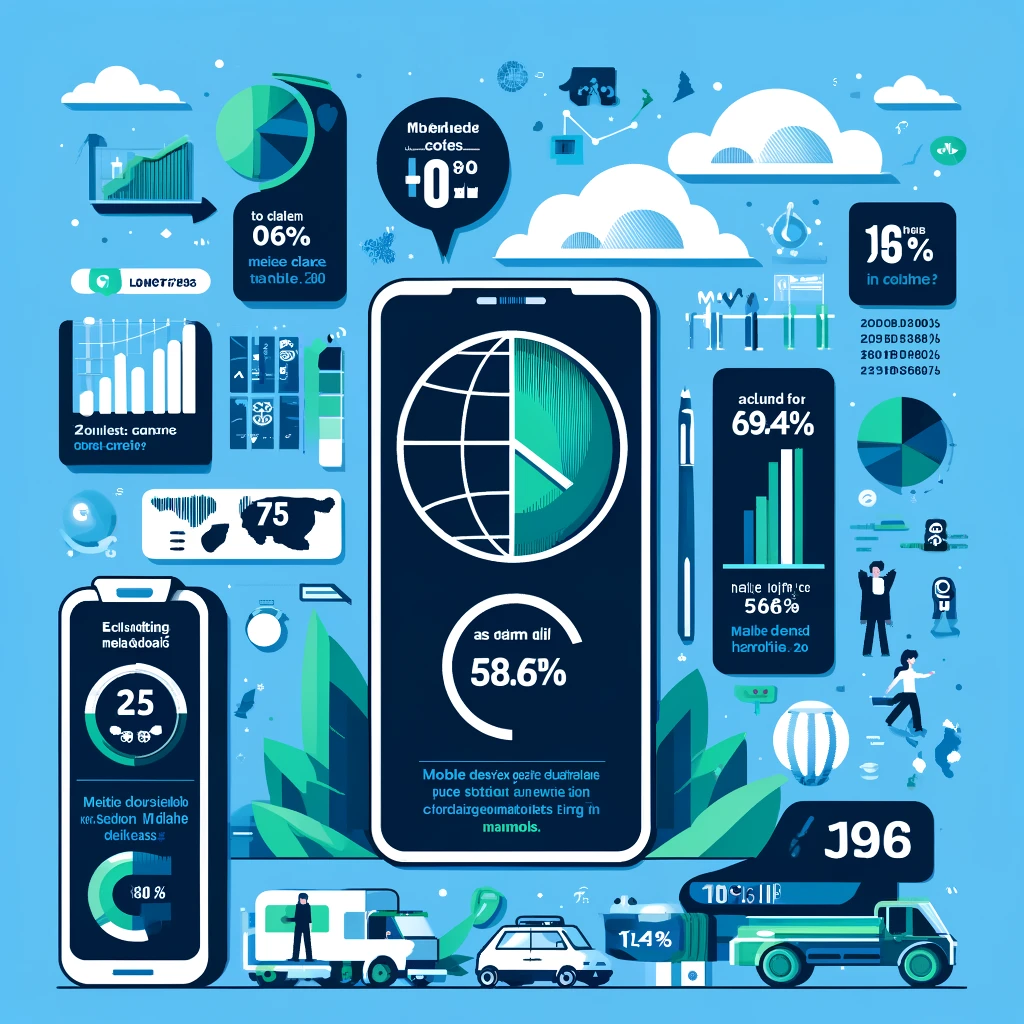
1. As of the last quarter of 2023, mobile devices (excluding tablets) accounted for 58.67% of global web traffic. This statistic is reported by Statista, a reliable source for various digital and consumer data .
[Ref: https://explodingtopics.com/blog/mobile-internet-traffic]
2. A 2024 report indicates that 60.67% of website traffic comes from mobile devices, underscoring the sustained dominance of mobile in online interactions. This figure is consistent with ongoing trends in mobile usage globally. [Ref: https://explodingtopics.com/blog/mobile-internet-traffic]
3. In March 2024, it was noted that 59.4% of all web traffic was via mobile phones, highlighting the persistent preference for mobile access over the years. [Ref: https://explodingtopics.com/blog/mobile-internet-traffic]
These statistics clearly show that a significant portion of users will access sites via mobile devices, making it crucial for any website, especially those serving specific professional sectors like migration agents and immigration lawyers, to ensure a seamless and effective mobile user experience.
Multilingual Support: Given the diverse backgrounds of your clients, consider offering multilingual support on your website.
This makes your services more accessible to non-English speakers and demonstrates cultural sensitivity.

Clear Calls to Action (CTAs): Use prominent CTAs to guide users toward engaging further with your services, whether it’s scheduling a consultation, downloading a guide on immigration processes, or subscribing to a newsletter.
Search Engine Optimisation (SEO)
Keyword Strategy: Developing a keyword strategy for your legal services in migration involves several key steps to ensure that you’re effectively targeting the right audience and improving your online visibility. Here’s an expanded approach:
Research Relevant Keywords: Start by identifying terms that potential clients might use to search for your services. These include basic keywords like “immigration lawyer,” “visa consultant,” and more specific ones like “work visa application” or “family sponsorship lawyer.”
Analyse Search Intent: Understand the intent behind the keywords—whether users are seeking information, looking to hire a service, or just researching. This helps in tailoring content that meets the user’s needs.
Use Keyword Tools: Leverage tools like Google Keyword Planner, SEMrush, or Ahrefs to find keyword volume, competition, and related phrases. This data is crucial for picking keywords that are not overly competitive yet have a decent search volume.
Local SEO: Local SEO is critical for migration agents serving specific geographic areas. By including local keywords like “immigration lawyer in [City]” or “[City] visa consultant,” you can significantly enhance your visibility in regional search results.
A pivotal component of Local SEO is optimising your Google Business Profile. This involves:
Accurate Information: Ensure your business name, address, and phone number are consistent across all platforms.
Keyword Optimisation: Include relevant local keywords in your profile’s description and posts.
Customer Reviews: Encourage satisfied clients to leave positive reviews, which can improve your business’s visibility and attractiveness.
Photos and Updates: Regularly update your profile with photos and news related to your services.






Local Listings: Besides Google, ensure your business is listed in local directories and relevant legal and immigration lists.
Effectively leveraging your Google Business Profile helps you tap into localised search queries, which are highly targeted and often have a higher conversion rate.
[Case Study: “5 Months GMB Accounting Client, Generates 442 Calls“]
[Ref: “How to Use Google My Business to Get More Customers” ]
Long-tail Keywords: Incorporate long-tail keywords—longer and more specific phrases that visitors are likely to use when they’re closer to a point of purchase or when they’re using voice search.
Competitor Analysis: Look at the keywords your competitors are targeting. This can provide insights into gaps in their strategies that you could exploit, or successful keywords that might also benefit your practice.
Integration: Seamlessly integrate these keywords into your website’s content, blogs, whitepapers, and FAQs. This not only helps in ranking higher in search results but also in making your content valuable and informative.
[Ref: “10 Basic WordPress SEO Mistakes“]
Monitoring and Adjustment: Keyword trends can change, so regularly review and adjust your keywords based on performance metrics and evolving search patterns.
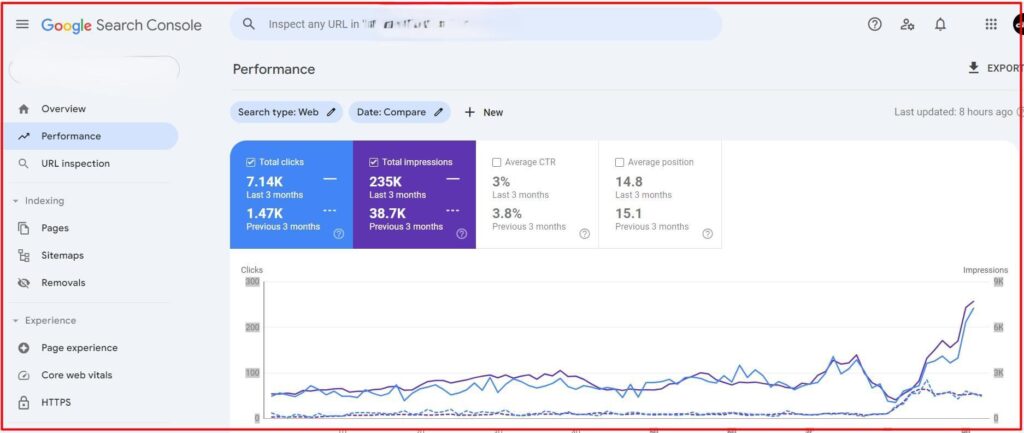
By thoroughly researching and strategically implementing keywords, you can significantly enhance the effectiveness of your digital marketing efforts, attracting more qualified leads and converting them into clients.
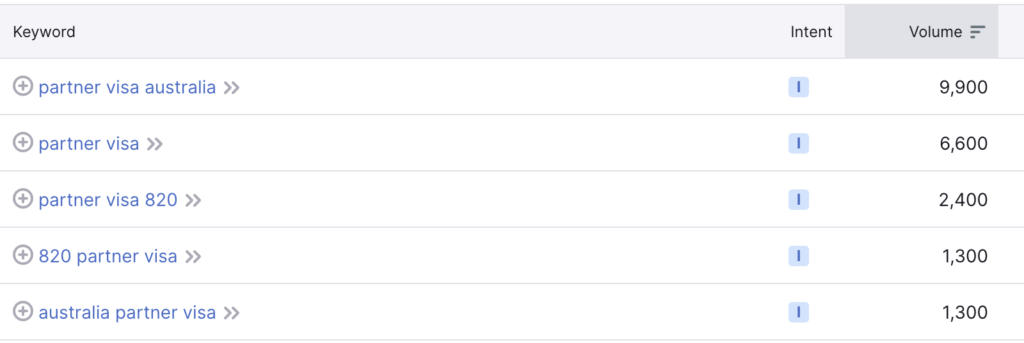
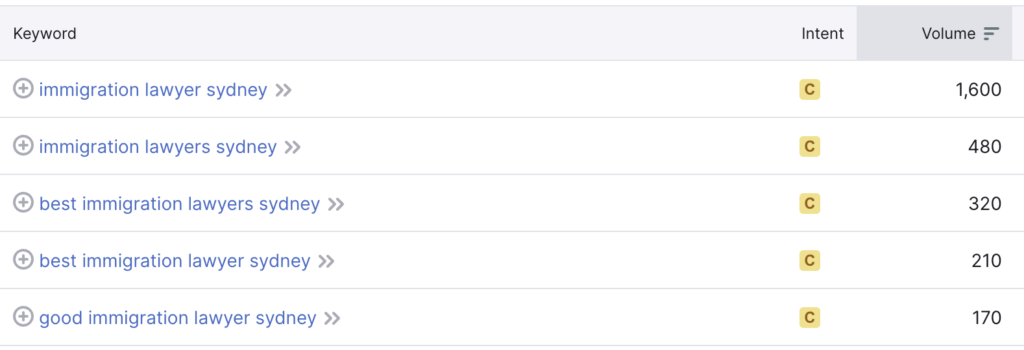
SEO Strategy Pricing Table:
When it comes to enhancing the online visibility of your migration practice, a tailored SEO strategy is indispensable. Below, we provide a pricing table that outlines potential SEO packages designed to meet a variety of needs from basic optimisations to comprehensive service enhancements.
Each migration practice is unique, with its own specific challenges and objectives. Therefore, we strongly recommend a personal consultation to accurately assess your needs and tailor our approach accordingly.
This ensures that the SEO strategy not only fits your budget but also effectively aligns with your practice’s goals, providing you with the best possible outcomes in terms of online presence and client engagement.
Through a detailed consultation, a customised SEO plan can be developed that addresses the specific aspects of your practice’s online activities, from enhancing your website’s technical framework to improving content and building a strong backlink profile.
[Ref: “A Curated List of Link Building Services – 2024“]
This personalised approach guarantees that every element of the SEO strategy is optimised to support the growth and success of your migration services.

Explanation of Services:
On-Page SEO: Focuses on optimising visible page elements that affect rankings, involving adjustments to textual and visual content, as well as HTML source code which helps search engines understand the relevancy and context of your pages.
Technical SEO: Ensures that the site meets the technical requirements of modern search engines for improved organic rankings. Key aspects include site architecture, mobile optimisation, and page speeds, along with secure and accessible URLs.
Backlink Services: Enhances the site’s authority and credibility through the acquisition of high-quality inbound links from other reputable sites. This also includes analysing competitor link-building strategies for insights.
Each pricing tier is designed to scale with the needs and budget constraints of different migration agents, ensuring that there are options suitable for new entrants to the market as well as established players looking to enhance their online presence significantly.
Content Quality: Publish high-quality, informative content that addresses common questions and concerns of your target audience.
This could include blog posts on recent changes in immigration law, how-to guides for visa applications, and success stories from your clients.
Local SEO: Optimise your website for local search results, which is crucial for legal practices that often serve clients in specific geographic areas.
Ensure your practice’s name, address, and phone number (NAP) are consistent across all digital platforms and directories.

Technical SEO: Ensure your website’s technical health by improving page speed, securing your site with HTTPS, and creating an XML sitemap.
These factors are considered by search engines when ranking sites.
Leveraging Technology
Chatbots and AI: Implement chatbots to provide immediate assistance to website visitors. These can answer common queries, direct users to relevant sections of the website, and even help schedule appointments, providing a 24/7 service that can capture leads even outside of business hours.
Virtual Consultations
Schedule a Video Call: Offer an easy booking system for free initial consultations via video call. This personal touch can make potential clients feel more comfortable and valued.
Video Content: Include video content such as client testimonials, explainer videos on key immigration topics, and introductions to your team.
Videos can significantly increase user engagement and time spent on your site, which are positive signals to search engines.
Interactive Tools
Visa Eligibility Quiz: Create an interactive quiz that helps users determine their eligibility for different types of visas. This not only provides value but also engages users interactively.
Cost Calculator: Implement a tool that estimates the potential costs of various immigration services based on user input. This can help demystify expenses and prepare clients for financial commitments.
Analytics and Feedback
Use Analytics: Utilise tools like Google Analytics to track visitor behavior on your website.
This data can help you understand which parts of your website are performing well and which need improvement.
Feedback Mechanisms: Incorporate feedback tools on your website to gather insights directly from users. This can help continuously refine and enhance the user experience.
By focusing on these essential digital marketing strategies, migration agents and immigration lawyers can build a strong online presence that attracts more clients, provides valuable information, and establishes their authority in the field.
Content Marketing for Migration Practice
Content marketing is an essential strategy for migration agents and immigration lawyers, as it helps establish credibility, attract potential clients, and inform the public about complex immigration laws and processes.
Blogging
Purpose and Benefits:
Educational Tool: Blogging allows legal professionals to break down complicated immigration laws and visa processes into understandable articles, helping potential clients navigate their concerns more efficiently.
SEO Advantages: Regularly updated blogs with relevant keywords can significantly improve a firm’s search engine rankings, making it more visible to those searching for immigration assistance.
Client Engagement: Blogs provide a platform for interaction through comments and questions, fostering a relationship between the firm and its audience.
Implementation Tips:
Consistent Schedule: Maintain a regular posting schedule to keep the audience engaged and ensure a steady flow of content.
Diverse Topics: Cover a range of topics from basic immigration advice, updates on law changes, case studies, and answers to common questions to cater to a broad audience.
Guest Blogging: Invite other experts in immigration law or related fields to write guest posts, which can increase your credibility and reach.
eBooks and Whitepapers:
Purpose and Benefits
Lead Generation: eBooks and whitepapers are excellent for capturing leads. By offering detailed and specialised content in exchange for contact information, you can build a database of potential clients who have shown interest in specific immigration topics.
Authority Building: Publishing in-depth guides on complex subjects such as the migration impact due to new policies or detailed visa application processes establishes you as an authority in the field.
Resource Sharing: These resources can be used by other legal professionals, policymakers, or academics, broadening your influence and professional network.
Implementation Tips:
Targeted Content: Develop content that addresses the specific needs or pain points of your target audience. For instance, an eBook titled “Guide to Securing a Work Visa in Australia” directly appeals to those looking to move for employment purposes.
Professional Design: Invest in professional design for your eBooks and whitepapers to ensure they are visually appealing and reflect the professionalism of your legal practice.
Promotion Strategies: Promote these resources through your blog, social media channels, email newsletters, and on relevant online forums and discussion groups.
Best Practices in Content Marketing
Quality Over Quantity: Ensure that the content is well-researched, factually accurate, and offers real value to the reader. Quality content not only attracts readers but also retains them.

Use of Analytics: Regularly analyse the performance of your content to understand what works best for your audience.
Tools like Google Analytics can help track downloads, page views, and interaction rates.
Feedback and Updates: Encourage feedback on your published content and be prepared to update your eBooks and whitepapers as new immigration laws and regulations come into effect.
By integrating these content marketing strategies into their digital marketing efforts, migration agents and immigration lawyers can significantly enhance their online presence, build trust with potential clients, and position themselves as thought leaders in the field of immigration law.
Social Media Marketing for a Migration Agent’s Practice
Social media marketing is a vital component of promoting a migration agent’s practice, enabling them to reach a diverse audience, engage with potential clients, and establish their expertise in the field of immigration law.
Below is a overview of key platforms and specific content strategies tailored for each to maximise their impact.
Platform Overview
Facebook
Audience: Broad, with a significant portion over the age of 30, ideal for reaching families and professionals considering migration.
Features: Supports text, images, videos, live streaming, and paid advertising. Groups and Events are particularly useful for community building and engagement.
Instagram
Audience: Skews younger, perfect for reaching potential clients in their 20s to 40s who are tech-savvy and consume visual content.
Features: Primarily visual; stories, posts, and IGTV offer great ways to share engaging visuals and short videos.
LinkedIn
Audience: Professionals and business-oriented users, suitable for targeting high-skilled migrants, corporate clients, and industry connections.
Features: Ideal for publishing articles, company updates, and professional endorsements that enhance credibility.
TikTok
Audience: Predominantly younger users who favor engaging, trendy, and quick content.
Features: Short-form video content, which can be used to create quick, informative, or behind-the-scenes content that humanises the brand.
YouTube
Audience: Broad demographic reach, with users looking for detailed informational content.
Features: Long-form video content ideal for detailed explanations, how-to guides, and client testimonials.

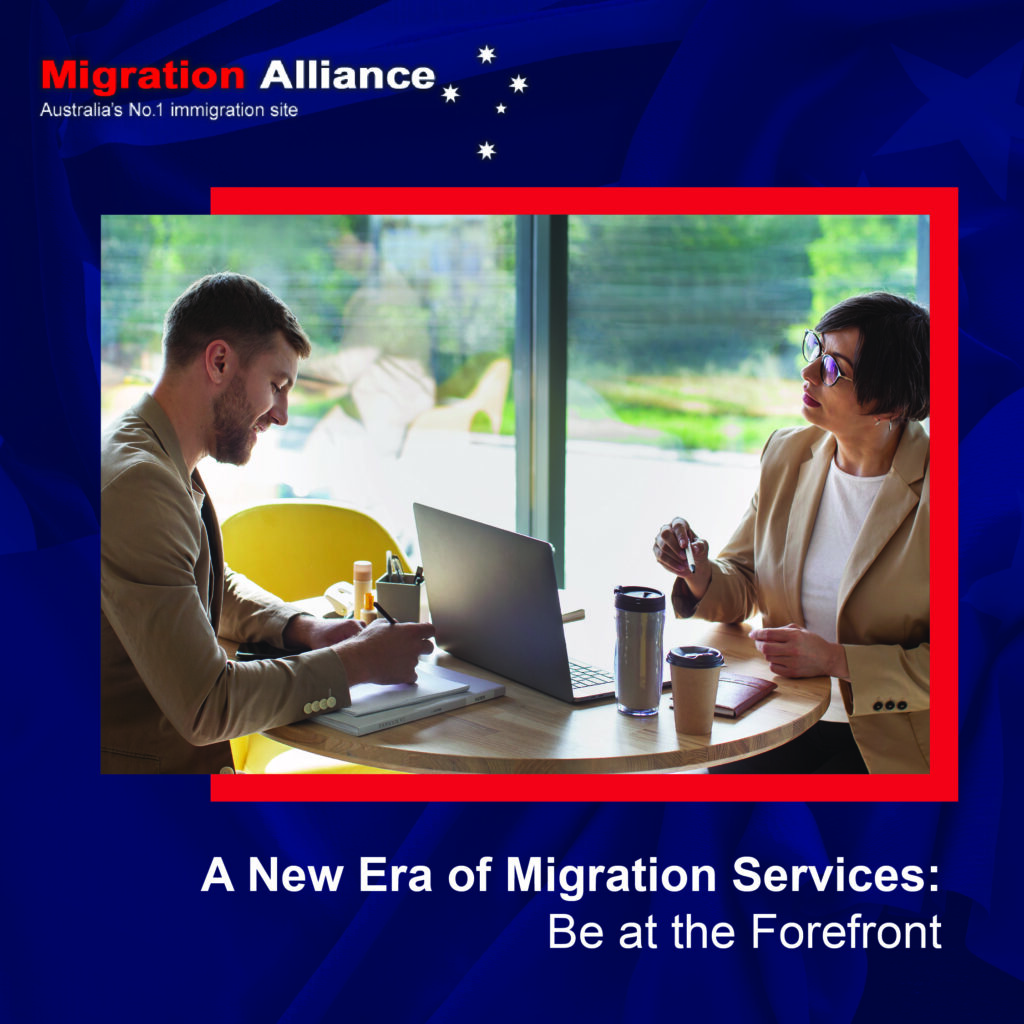
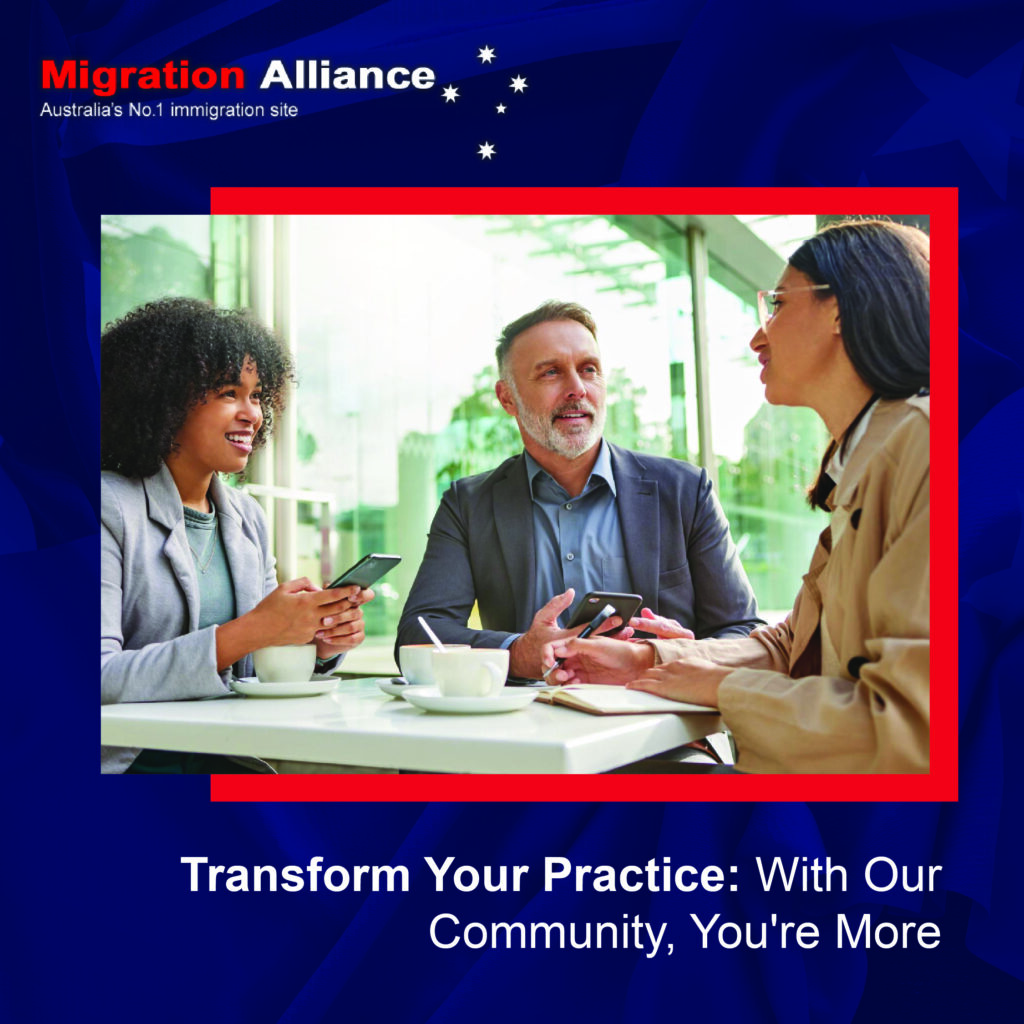
Content Strategies for Each Platform
Facebook
Educational Content: Share detailed blog posts, infographics, and short videos explaining complex immigration processes.
Live Q&A Sessions: Regularly host live sessions to answer common immigration questions, showcasing your expertise.
Community Engagement: Create a community group for expats from specific countries or those looking to migrate to Australia.
Instagram
Visual Stories: Use visually appealing graphics to simplify visa processes or success stories in a carousel or story format.
Behind-the-Scenes: Share images and videos showcasing the day-to-day workings of your office or team interactions, adding a personal touch.
Instagram Reels: Create short, engaging clips on tips for successful visa applications or common mistakes to avoid.
LinkedIn
Professional Articles: Publish articles discussing recent changes in immigration law, case studies, or professional advice, establishing thought leadership.
Networking Content: Regular updates on attending or speaking at immigration law conferences, workshops, or other professional gatherings.
Client Success Stories: Share testimonials and case studies that highlight your expertise and successful outcomes.
TikTok
Quick Tips Series: Post quick tips about different visa types or the migration process, using trending sounds and hashtags to increase reach.
Day in the Life: A day in the life of a migration agent to show the personal side of your profession.
Fun Facts: Light-hearted, informative videos about common misconceptions in immigration law and migrating to Australia.
YouTube
In-depth Guides: Create detailed video guides on how to navigate complex immigration processes or changes in immigration law.
Client Interviews: Feature interviews with past clients who successfully migrated, focusing on their stories and experiences.
Educational Series: Develop a series of videos that cover various aspects of immigration law, from basic to complex topics.
By leveraging the unique strengths of each social media platform and deploying targeted content strategies, a migration agent can effectively promote their services, educate potential clients, and build a strong, engaged online community.
This approach not only increases visibility but also significantly enhances the agency’s reputation as a trustworthy and knowledgeable authority in immigration law.
VII. Email Marketing
Email marketing is an effective tool for migration agents to maintain communication with potential and existing clients, deliver targeted content, and nurture leads through personalised engagement.

Building an Email List
Building an email list is crucial for migration agents because it provides a direct channel to communicate with potential and existing clients.
An email list allows for targeted and personalised communication, which can enhance client engagement and retention.
It serves as a foundation for various marketing strategies, including newsletters, updates on immigration laws, and promotional offers, all of which can help build trust and establish the agent as an authority in the field.
Additionally, owning an email list reduces dependence on external platforms for reaching your audience, giving you more control over your marketing efforts.
Website Opt-In Forms
Placement: Incorporate opt-in forms prominently on your website, especially on high-traffic pages like the homepage, blog sections, and contact pages.
Incentives: Offer valuable resources, such as free guides on immigration processes or webinars, in exchange for email sign-ups to increase conversion rates.
Social Media Integration
Calls to Action: Utilise social media platforms to encourage followers to sign up for more detailed content delivered via emails.
Exclusive Offers: Promote content available only to email subscribers, like advanced notice of new services or changes in immigration law, to create exclusivity.
Offline Opportunities
Seminars and Conferences: Collect emails at industry events by offering digital handouts or entry into a giveaway for those who sign up.
Client Interactions: During consultations and follow-up meetings, ask clients if they would like to receive updates and useful information via email.
Email Campaign Strategies
Welcome Emails
Introduction: Send a warm and informative welcome email to new subscribers. Introduce your agency, highlight your expertise, and set expectations for the type of content they will receive.
Educational Series
Informational Content: Send a series of emails that educate recipients about various aspects of the immigration process, such as visa application steps, common issues, and how to prepare for a move.
Case Studies and Success Stories: Share stories of successful cases to illustrate how your agency has helped clients navigate complex immigration challenges.
Newsletters
Regular Updates: Provide regular updates on changes in immigration laws, upcoming events, and other relevant news that impacts your client base.
Personalised Advice: Include segments that address common questions or concerns, tailored to the needs and interests of your audience.
Promotional Emails
Service Promotions: Highlight specific services, such as visa application reviews or legal representation, with special offers or limited-time discounts.
Referral Programs: Encourage satisfied clients to refer friends and family, possibly offering both parties a discount or free consultation.
Metrics and Analysis
Open Rate
Benchmarking: Monitor the percentage of recipients who open your emails. A low open rate may indicate issues with your subject lines or overall subscriber engagement.
Click-Through Rate (CTR)
Engagement Measurement: Track the percentage of recipients who click on links within your email. This metric helps assess the relevance and effectiveness of your content and calls to action.
Conversion Rate
Action-Oriented Results: Measure how many email recipients take a desired action, such as filling out a contact form or scheduling a consultation. This is crucial for determining the ROI of your email campaigns.
Bounce Rate and List Growth Rate
List Health: Analyse how many emails are not delivered (bounce rate) and how your email list is growing over time.
High bounce rates may indicate outdated lists, while growth rates give insight into how well your list-building strategies are working.
Unsubscribe Rate
Subscriber Satisfaction: Keep an eye on how many people opt-out of your emails. A high unsubscribe rate might suggest that content is not resonating or is too frequent.
By effectively building an email list, implementing strategic email campaigns, and continuously analyzing performance metrics, migration agents can enhance their client engagement, boost their marketing efforts, and ultimately grow their practice.
VIII. Online Advertising
Online advertising is an essential strategy for migration agents looking to attract new clients and expand their digital presence.
It includes a variety of techniques that can be tailored to the specific needs of a migration practice.
Here’s how migration agents can leverage Pay-Per-Click (PPC) advertising, display ads, and retargeting campaigns effectively:
Pay-Per-Click (PPC) Advertising
Overview: PPC is a model of internet marketing where advertisers pay a fee each time one of their ads is clicked.
It’s essentially buying visits to your site, rather than attempting to earn those visits organically.

Search Engine Ads: Use Google Ads or Bing Ads to appear in search engine results when potential clients search for relevant keywords like “migration agents for Australia” or “best immigration lawyer for permanent resident visa.”
These ads can be finely tuned to display based on specific geographic locations, languages, and devices.
Keyword Strategy: Conduct thorough keyword research to target those most relevant to the services you offer.
Utilise long-tail keywords which are less competitive and more specific, such as “work visa lawyer in Sydney” or “family-sponsored visa application Australia.”
Landing Pages: Develop optimised landing pages that correspond to the ad clicks.
These pages should provide specific information related to the ad, such as a special offer, a detailed service description, or a contact form, to effectively convert visitors into leads.
Display Ads
Overview: Display ads are a form of PPC advertising that appear on websites in the form of banners, sidebars, or small boxes.
They’re designed to be visually appealing to draw attention and direct users to your website.
Targeting Options: Utilise targeting options provided by platforms like Google Display Network to show your ads on websites that are frequented by your target demographic.
You can target by topic, by the type of content on a website, or even by specific websites that your audience visits.
Creative Elements: Invest in high-quality graphics and a clear call-to-action (CTA) within your ads.
Since display ads are visual, an engaging design that reflects your brand can make your ad stand out and increase the chances of a click.
A/B Testing: Regularly test different versions of your ads to see which designs and messages perform best.
This data-driven approach can significantly improve your ad effectiveness over time.
Retargeting Campaigns
Overview: Retargeting works by keeping track of people who visit your site and displaying your retargeting ads to them as they visit other sites online.
It’s effective in keeping your brand visible and engaging users who have shown interest but haven’t yet converted.

Pixel-Based Retargeting: Implement a retargeting pixel on your website, which will start a cookie in the visitor’s browser.
This allows you to follow them over the internet with targeted ads that will remind them of the services you provide, encouraging them to return to your site.
List-Based Retargeting: If you have a list of emails from potential clients (e.g., from newsletter sign-ups or previous consultations), you can use these lists to run retargeting campaigns on social media platforms like Facebook and LinkedIn.
Personalisation: Customise the retargeting ads based on the specific pages that visitors have viewed on your website.
For example, if a visitor spent time on a page about family immigration, the retargeted ads they see could focus on your expertise in family-based visa applications.
By employing these targeted online advertising strategies, migration agents can effectively enhance their visibility online, attract more targeted traffic to their websites, and ultimately convert more of those visitors into paying clients.
Each type of advertising has its strengths and can be used in conjunction with others to create a comprehensive digital marketing strategy.
IV. Networking and Partnerships
Networking and forming strategic partnerships are crucial for migration agents looking to expand their reach, enhance their service offerings, and build a reputation within the industry.
Professional associations such as the Migration Alliance offer valuable platforms for these activities.
Identifying Potential Partners
Complementary Services: Identify businesses and professionals whose services complement yours, such as education consultants, recruitment agencies, and legal firms specialising in other areas of law.
These partnerships can provide a holistic service offering to clients looking to migrate, work, or study abroad.
Community Organisations: Connect with community organisations and cultural associations that cater to expatriates from various countries.
These groups can be valuable sources of referrals and can offer insights into the specific needs and challenges faced by immigrants from different backgrounds.
Industry Leaders and Influencers: Engage with well-known figures in the migration and broader legal field.
This includes authors, bloggers, or speakers who can provide endorsements or collaborate on content that enhances your credibility.
Building Strategic Alliances
Professional Associations: Leverage associations like [Migration Alliance] to network with peers and stay updated on industry trends.
Membership in such organisations often provides access to training resources, regulatory updates, and networking events that are crucial for professional development and business growth.
Leveraging Migration Alliance
Membership Benefits: As a member of Migration Alliance, take full advantage of the training sessions, legal updates, and forums provided.
These resources are invaluable for staying informed and compliant in a rapidly changing regulatory environment.
Directory Listings: Ensure your practice is listed in the Migration Alliance directory, increasing your visibility to those who seek migration assistance.
Active Participation: Engage actively in discussions and forums hosted by Migration Alliance.
Offering insightful advice and sharing your experiences can help establish you as a thought leader in the field.
By strategically networking and forming partnerships, migration agents can significantly enhance their business prospects and service quality.
Event Sponsorship and Attendance: Actively participate in and sponsor events related to migration and global mobility.
This not only increases your visibility within the industry but also demonstrates your commitment to the field.
Collaborative Projects: Work on joint initiatives, such as research studies, community outreach programs, or seminars, with other organisations.
These projects can boost your profile and lead to more comprehensive service offerings.
Affiliate Marketing
Affiliate Programs: Develop an affiliate marketing program where you reward individuals or companies for referring new clients to your services.
This can be particularly effective if you collaborate with travel agencies, educational institutions, and expat forums where potential clients first seek information.
Online Platforms: Utilise online platforms to extend your reach. This includes writing guest posts for blogs, participating in webinars, or contributing to digital publications that target your desired audience.
Technology-Based Partnerships: Consider partnerships with tech companies offering tools relevant to migrants, such as language learning apps or job search platforms.
Integrating your services with these tools can provide a seamless experience for clients and increase referrals.
X. Client Retention Strategies
Client retention is crucial for maintaining a successful migration practice. Effective strategies not only ensure continuous business from existing clients but also enhance referrals through positive word-of-mouth.
Below are key strategies that migration agents can implement to improve client retention:
Client Relationship Management (CRM) Systems
Implementation of CRM Software: Invest in a robust CRM system tailored for legal or migration services.
CRM tools help manage client data, track interactions, and automate communication.
This technology supports personalised service delivery by providing detailed insights into client histories, preferences, and past communications.

Data Utilisation: Use the data collected through CRM to understand client needs better and anticipate their requirements.
For example, if a client’s visa renewal date is approaching, the CRM can trigger a reminder to the agent to reach out and offer renewal services.
Client Segmentation: Segment your clients based on their service type, needs, or status, and tailor communication and service offerings accordingly.
This targeted approach ensures that clients receive relevant information and feel valued, increasing satisfaction and loyalty.
Loyalty Programs
Reward Schemes: Develop a loyalty program that rewards clients for repeat business and referrals.
Rewards could include discounts on future services, free consultation hours, or complimentary attendance at immigration seminars.
Exclusive Offers: Provide clients enrolled in the loyalty program with exclusive offers, such as priority service, extended support hours, or access to premium resources.
This exclusivity adds value to your services and enhances client engagement.
Feedback and Adaptation: Regularly solicit feedback from clients about their experience and the rewards program.
Use this input to refine and adapt the program to better meet their needs and expectations.
Regular Client Communication
Newsletters: Send out a regular newsletter that includes updates on immigration law, case studies, and helpful tips.
Newsletters keep your practice top-of-mind and demonstrate ongoing value to your clients.
Personal Check-Ins: Schedule periodic check-ins with clients to discuss their current situations and future needs.
These personal interactions can be conducted via phone calls, emails, or even face-to-face meetings, depending on the client’s preference.
Educational Content: Offer webinars, workshops, and articles that address common concerns or new changes in immigration policy.
Providing clients with this valuable information helps them feel supported and informed, reinforcing their decision to choose your services.
Utilising Technology
Automated Reminders: Use automated systems to send reminders for important dates related to clients’ immigration applications, such as application deadlines or appointment reminders.
This proactive approach shows clients that you are attentive and managing their cases effectively.
Online Client Portals: Develop a secure online portal where clients can access their case files, track the status of their applications, and communicate directly with your office.
Portals enhance transparency and convenience, which are critical factors in client satisfaction.
By implementing these client retention strategies, migration agents can build stronger relationships, enhance client satisfaction, and increase the likelihood of both repeat business and referrals.
Each strategy contributes to a comprehensive approach to client engagement and service excellence, key components of a thriving migration practice.
XI. Measuring Success
To effectively manage and enhance their services, migration agents need to implement a robust system for measuring success.
This involves defining key performance indicators (KPIs), utilising advanced tools for tracking and analysis, and continuously adjusting strategies based on performance data.
Key Performance Indicators (KPIs)
KPIs are crucial metrics that help migration agents measure the effectiveness of their strategies and ensure they are on track to achieve their business objectives.

Specific KPIs might include:
Client Acquisition Rates: Tracks the number of new clients acquired over a specific period. This indicator helps assess the effectiveness of marketing and outreach efforts.
Client Retention Rates: Measures how many clients remain engaged with the agency over time. High retention rates can indicate client satisfaction and effective ongoing service.
Conversion Rates: The percentage of leads that turn into clients. This metric is essential for evaluating the success of sales strategies and lead management processes.
Application Success Rates: Specifically important for migration agents, this KPI tracks the percentage of client applications (e.g., visas, citizenship applications) that are successfully approved.
Revenue Growth: Measures increases in revenue, helping to assess overall business health and the success of various pricing strategies.
Client Satisfaction Scores: Gathered through surveys and feedback forms, these scores provide qualitative data on client satisfaction and can highlight areas needing improvement.
Tools for Tracking and Analysis
Effective measurement requires robust tools that can capture data accurately and provide insightful analytics.
Google Analytics: Offers comprehensive tracking of website traffic, user behavior, and conversion metrics.
It’s vital for understanding how users interact with your website and identifying which pages or content drive the most engagement.
CRM Software: Beyond managing client relationships, CRM systems often feature built-in analytics to track client interactions, service outcomes, and overall engagement levels.
Social Media Analytics: Platforms like Facebook, LinkedIn, and Twitter provide detailed insights into post performance, audience demographics, and engagement rates.
Email Marketing Tools: Services like Mailchimp and HubSpot track open rates, click rates, and conversions from email campaigns, providing insights into how effectively these campaigns drive client engagement and acquisition.
Financial Software: Tools like QuickBooks or Xero can help track revenue growth, manage budgets, and analyse financial health over time.
Adjusting Strategies Based on Performance
The final step in measuring success is using the insights gained from KPIs and analytics tools to refine and adjust business strategies:
Data-Driven Decisions: Make informed decisions based on the data collected. For example, if application success rates are low, consider enhancing the training for staff handling applications or revising the pre-screening processes.
A/B Testing: Regularly test different approaches in marketing and client service to see what works best. For instance, test two different email campaigns to see which yields better conversion rates.
Client Feedback Incorporation: Use client feedback to continuously improve service offerings. If clients express dissatisfaction with certain aspects of the service, adjust these areas promptly.
Resource Allocation: Allocate more resources to high-performing strategies and consider scaling down or discontinuing underperforming services or marketing efforts.
Continuous Learning and Development: Encourage ongoing training and development for staff based on trends identified in performance data, ensuring that the team remains at the forefront of industry standards and best practices.
By establishing a cycle of setting KPIs, tracking them through appropriate tools, and adjusting strategies based on the results, migration agents can ensure sustained growth and improvement in their services, ultimately leading to greater client satisfaction and business success.
XII. Case Studies
Case studies are an invaluable resource for migration agents, offering insights into successful strategies and lessons from less successful endeavours.
Analysing both successes and failures helps refine practices, enhance client services, and improve overall success rates.
Success Stories from the Industry
Detailed Client Journeys: Document the full journey of clients from the initial consultation to the successful resolution of their cases.
Include specifics such as the challenges faced, strategies employed, and the key factors contributing to the success.
Case Study Example 1: Streamlining Family Visa Applications through Proactive Strategy

Background:
Migration Matters, a Sydney-based migration agency, was approached by the Chen family, who were seeking to reunite with their grandparents living in China.
The family was concerned about the complexities and potential long waiting periods associated with the subclass 143 Contributory Parent visa process.
Challenge:
The primary challenge was the extensive documentation required and the high cost of the visa application, which included significant health and character checks for the elderly applicants.
Additionally, the Chens were anxious about the processing times, which could extend up to several years.
Strategy Implemented:
Migration Matters took a proactive approach by first conducting a thorough initial assessment to ensure that all potential issues were identified upfront.
The agency:
– Conducted detailed consultations to gather comprehensive background information and set realistic expectations about the timeline and costs.
– Prepared a pre-application checklist and timeline, helping the family organise necessary documents well in advance.
– Engaged a medical liaison to facilitate the health checks required for the grandparents, ensuring that all medical documentation met the strict criteria set by immigration authorities.
– Implemented a staggered submission strategy to manage and mitigate the financial burden, spreading out the significant costs associated with the application.
Outcome:
The proactive and detailed preparation led to the submission of a well-documented and complete application that required no further correspondence from the Department of Home Affairs.
The visa was granted in 18 months—significantly less than the average processing time, largely due to the completeness of the application and the strategic timing of submissions.
Client Feedback:
The Chen family expressed deep satisfaction with the services provided by Migration Matters, particularly appreciating the clear communication and the strategic approach that eased their financial concerns and reduced the processing time.
Lessons Learned:
This case highlighted the importance of meticulous preparation and proactive strategy in handling complex visa applications. Migration Matters learned the value of:
– Setting clear expectations with clients about potential challenges and timelines.
– Preemptive planning to streamline the documentation and application phases.
– Regular updates and communication with clients to keep them informed and engaged throughout the process.
Future Applications:
The success of the Chen family’s application has encouraged Migration Matters to adopt similar strategies with other clients, particularly in complex family reunification cases, thereby enhancing their reputation and client satisfaction.
The case study serves as a valuable example for other migration agents seeking to improve their service delivery and client success rates.
Diverse Case Types: Compile success stories across a variety of case types, such as family visas, work permits, asylum cases, and more.
This diversity not only illustrates the agency’s breadth of expertise but also caters to a wider audience by addressing multiple client needs.
Quantifiable Results: Whenever possible, include quantifiable outcomes such as approval rates, processing times, or statistical comparisons with industry averages.
This data adds credibility and concrete evidence of success.
Client Testimonials: Integrate client testimonials within these case studies to add a personal touch and showcase satisfaction from the clients’ perspectives.

Multimedia Presentation: Present these case studies through various media formats, including written documents, video testimonials, and infographics, making them accessible and engaging for different audiences.
Lessons Learned from Failed Campaigns
Honest Analysis: Address campaigns that did not meet expectations openly and analytically. Identify what went wrong, such as misjudged client eligibility, inadequate documentation, or unforeseen legal changes.
Corrective Actions: Discuss the steps taken to correct or improve processes after a setback.
This could involve additional training for staff, revised consultation procedures, or enhanced client screening processes.
Resilience and Adaptation: Highlight how the agency adapted to these challenges, underscoring resilience and flexibility in handling immigration cases.
This demonstrates commitment to continuous improvement and client service excellence.
Preventive Measures: Share new practices or systems put in place to prevent similar failures in the future, such as improved legal research methods, enhanced communication protocols, or new technology implementations.
Educational Value: Use these experiences as educational tools not only internally for training purposes but also for clients through blogs or newsletters, showing them the complexities of immigration processes and how your agency navigates these challenges.
Case Study Example 2: Addressing and Learning from a Visa Application Failure

Background:
Global Pathways, a migration agency based in Melbourne, Australia, encountered a significant challenge when handling the visa application of Mr. Samuel Diaz, a software engineer from Colombia looking to secure a skilled worker visa.
Challenge:
Mr. Diaz’s visa application was rejected due to insufficient documentation demonstrating his work experience and qualifications, which are crucial for the skilled worker visa category.
Additionally, there was a misunderstanding regarding the level of English proficiency required, as the client had not been properly informed about the need to meet specific language benchmarks.
Immediate Response:
Upon receiving the rejection notice, Global Pathways conducted a thorough review of the entire application process.
They identified key areas where misunderstandings and miscommunications had led to the failure:
– Documentation: The agency had not verified the completeness of the documentation concerning Mr. Diaz’s professional experience.
– Communication: There was a lack of clear communication regarding the English language requirements, leading to the client not taking the necessary language tests on time.
Strategy Implemented:
To address these issues and prevent future failures, Global Pathways implemented several strategic changes:
– Improved Documentation Processes: They established a checklist for all client applications to ensure that no document is overlooked.
This checklist is now reviewed by multiple team members before submission.
– Client Education Program: Global Pathways developed a comprehensive client education program that includes detailed sessions on the key requirements for different visa types, focusing on common pitfalls like language and document verification.
– Regular Training for Agents: The agency introduced bi-monthly training sessions for all staff, focusing on changes in immigration law and visa requirements, aiming to keep all team members updated and equipped to handle complex cases.
Outcome:
After implementing these changes, Global Pathways reached out to Mr. Diaz to assist him in reapplying.
With the new processes in place, his application was carefully prepared with all necessary documentation and language certification.
The application was successful on this second attempt.
Client Feedback:
Mr. Diaz expressed his appreciation for the agency’s commitment to rectifying the initial oversight and was particularly pleased with the transparent and educational approach taken during his second application process.
Lessons Learned:
This case underscored the importance of meticulous documentation and clear communication with clients regarding all requirements.
It also highlighted the need for ongoing staff training to adapt to continually changing immigration laws and standards.
Future Applications:
Global Pathways has since used this experience to improve their service quality and client satisfaction, turning a significant failure into a learning opportunity that enhanced their operational procedures and client handling strategies.
This case study now serves as an essential learning tool within the agency, ensuring that past mistakes lead to future successes.
Leveraging Case Studies for Business Growth
Marketing and Promotion: Use case studies in marketing materials to demonstrate expertise and build trust with potential clients.
Highlighting specific success stories can be a powerful tool in promotional campaigns.
Professional Development: Internally, use both successful and unsuccessful case studies as learning tools to help staff understand effective strategies and areas needing caution.
Industry Contributions: Share case studies with broader industry forums or publications to contribute to the collective knowledge pool and establish your agency as a thought leader in the field of migration.
By systematically documenting and analysing both successful and less successful cases, migration agents can not only improve their service offerings but also strengthen their market position by demonstrating expertise and transparency.
This approach not only enhances client trust but also contributes to the overall professionalism and efficacy of the migration consulting industry.
XIII. Future Trends in Migration Services

As the global landscape evolves, so do the methods and technologies used to market migration services.
Staying ahead of these changes not only helps migration agents remain competitive but also enables them to provide better services to their clients.
Here’s a look at the emerging technologies and predictions for market changes that are likely to influence the future of marketing migration services.
Emerging Technologies
Artificial Intelligence (AI) and Machine Learning (ML)
Automated Customer Service: AI-driven chatbots and virtual assistants can handle initial consultations, answer FAQs, and schedule appointments, improving client engagement and operational efficiency.
Predictive Analytics: Machine learning algorithms can analyze past immigration application data to predict outcomes, tailor marketing strategies, and personalize client interactions. This allows for more targeted marketing and better client service.
Document Automation and Analysis: AI tools can help in the automatic filling and review of application forms, ensuring accuracy and compliance with the latest immigration laws, thereby reducing human error and speeding up the application process.
Blockchain Technology
Secure Client Data Management: Blockchain could revolutionise how client data is stored and shared, enhancing privacy and security.
Secure, decentralised systems for sharing information between stakeholders (clients, immigration offices, and third parties) could streamline processes and increase transparency.
Smart Contracts: These could automate the agreement and payment processes between clients and service providers once certain conditions are met, reducing paperwork and increasing trust through transparent, immutable records.
Predictions for Market Changes
Increased Regulation and Compliance Demands
Stricter Policies: As immigration policies may tighten globally, migration agents will need sophisticated tools to manage complex applications and maintain high success rates.
Compliance Tools: The development of advanced software to ensure full compliance with changing legal frameworks will be crucial.
Greater Emphasis on Client Relationship Management
Personalised Services: As the market becomes more competitive, providing personalised experiences will be essential.
CRM systems will likely evolve to offer even more detailed insights into client preferences and histories.
Retention Strategies: Agencies will increasingly focus on client retention through loyalty programs, regular personalised communications, and value-added services.
Expansion of Digital and Social Media Marketing
Video Marketing: With the rise of platforms like YouTube, TikTok, and Instagram, video content will become an even more critical element of engaging potential clients.
Influencer Partnerships: Collaborating with influencers in the expat and travel communities could become a more prevalent strategy for reaching potential clients in less formal, more relatable ways.
Integration with Global Mobility Services
Holistic Services: Migration agencies might start offering more comprehensive relocation services, integrating with real estate, job placement, and cultural integration services to provide a one-stop-shop experience.
Sustainability and Social Responsibility
Eco-friendly Practices: With growing global focus on sustainability, migration agencies that adopt and promote environmentally friendly practices in their operations and marketing might appeal more to eco-conscious clients.
Community Engagement: Agencies will increasingly engage in social responsibility initiatives, both locally and globally, to enhance their brand image and give back to the community.
By anticipating and adapting to these future trends, migration agents can position themselves to meet the evolving needs of their clients and navigate the complexities of the global migration landscape effectively.
XIV. Conclusion
As we wrap up our exploration of marketing strategies for migration practices, it’s vital to revisit the key tactics discussed and reflect on how they integrate to form a comprehensive marketing approach.
We also consider the broader implications of these strategies for ensuring the success and growth of a migration agency.

Recap of Key Marketing Strategies
1. Digital Presence and SEO: The foundation of a successful marketing strategy in today’s digital-first world hinges on a strong online presence.
A well-designed website, optimised for search engines through thoughtful SEO practices, ensures that your services are visible to those in need.
Techniques like keyword optimisation, quality content creation, and mobile-friendly design are not just digital tactics but essential tools that drive engagement and conversions.
2. Social Media Engagement: Platforms like Facebook, Instagram, LinkedIn, and newer entrants like TikTok, provide powerful avenues to connect with different segments of your target audience.
Each platform serves unique purposes, from building professional networks on LinkedIn to engaging younger audiences on TikTok with dynamic video content, all fostering relationships and enhancing brand visibility.
3. Content Marketing: This strategy revolves around creating and distributing valuable, relevant, and consistent content to attract and retain a clearly-defined audience.
By addressing the specific needs and questions of potential clients through blogs, eBooks, and videos, you position your agency as a knowledgeable and trustworthy source.
4. Client Relationship Management: Employing advanced CRM systems aids in managing client interactions and data throughout the client lifecycle, enhancing customer service and driving business growth.
These systems are instrumental in collecting insights that help tailor your marketing strategies to client needs and preferences.
5. Email Marketing: Effective use of email marketing involves sending targeted campaigns to nurture leads and keep your brand top of mind among existing clients.
Segmentation, personalised content, and regular updates about your services encourage ongoing engagement and loyalty.
6. Online Advertising: Leveraging PPC advertising, display ads, and retargeting campaigns can significantly boost your visibility online.
These tools allow for precise targeting and measurement, offering insights into campaign performance and ROI.
7. Professional Networking and Partnerships: Building relationships with other professionals and engaging in industry associations like the Migration Alliance enrich your knowledge and resource base, opening up referral opportunities and collaborative possibilities.
8. Client Retention: Implementing loyalty programs, regular client communication, and soliciting feedback are crucial for maintaining and deepening existing client relationships.
These efforts ensure clients feel valued and are more likely to return and refer others.
Final Thoughts on Effective Marketing in Migration Practice
Effective marketing is not just about spreading the word but creating meaningful connections that resonate with potential clients on a personal level.
It’s about understanding their journey, the challenges they face, and providing solutions that ease their path towards achieving their migration goals.
The strategies discussed are interconnected, each reinforcing the others.
For example, content generated for SEO purposes can be repurposed across social media and email campaigns, creating a cohesive and unified brand message.
Moreover, the role of technology cannot be overstated—from the use of AI in personalising interactions to the potential of blockchain for secure document handling, staying ahead of technological advancements can provide significant competitive advantages.
Ultimately, the goal is to foster trust and reliability, making your migration agency the go-to expert in a crowded and often confusing market.
By consistently applying these targeted strategies and adapting to the evolving digital landscape and regulatory environments, your practice can not only survive but thrive, growing a loyal client base and a respected brand reputation.
XV. About the Author
Ben Miranda is a seasoned digital marketing strategist and the driving force behind Havoc Digital, where he specialises in crafting innovative marketing solutions for migration agents and immigration law firms.
With over a decade of experience, Ben has a robust background in SEO, PPC, and client relationship management, honed through significant work in various high-profile digital marketing agencies.
Philosophy and Contributions
Ben is known for his data-driven approach to marketing, emphasising analytics to tailor strategies that meet the specific needs of the migration sector.
He is a regular contributor to industry publications, offering insights on leveraging digital tools to improve business outcomes.
XVI. Research References
Department of Home Affairs, Australia: This is the primary source for up-to-date policies, annual reports, and immigration statistics. It offers detailed insights into the current rules and procedures governing immigration. [Link to Department of Home Affairs]
Migration Legislation Amendment Act: This document provides details on recent amendments to the immigration policy and the impact of these changes. You can find this in the Federal Register of Legislation. [Link to Federal Register of Legislation]
Australian Immigration Law – A. Millbank: This book provides a detailed analysis of the legal aspects of Australian immigration policy, including historical evolution and case studies.
Australian Immigration and Asylum Policy: Historical and Contemporary Issues”: An academic journal article that covers the history and current issues in Australian immigration and asylum policies. Available in journals like the Australian Journal of Political Science.
“Immigration Detention in Australia” by Human Rights Watch: A report discussing the human rights aspects of Australian immigration detention practices. [Link to Human Rights Watch]
The Lowy Institute Reports on Immigration: The Lowy Institute provides numerous policy papers and analysis that critique and discuss the broader implications of immigration policies in Australia. [Link to The Lowy Institute]
“The Politics of Australian Immigration” edited by James Jupp: This book offers an in-depth look at the political discourse surrounding immigration policies in Australia over several decades.
The Conversation – Articles on Australian Immigration: The Conversation features explanatory articles written by academics and researchers on current issues affecting Australian immigration policies. [Link to The Conversation]
Refugee Council of Australia Reports: Provides reports and submissions on issues affecting refugees and asylum seekers, offering a critical view of the government’s policies. [Link to Refugee Council of Australia]
Australian Parliamentary Library Briefings: Offers comprehensive briefs on specific immigration policies, legislative changes, and debates in parliament. [Link to Parliamentary Library]
[END]
